#Used Renault Master engine
Explore tagged Tumblr posts
Text

The Truth About Installing a Remanufactured Renault Master Engine: DIY or Hire a Pro?
#Remanufactured Renault Master engine#Used Renault Master engine#Renault Master engine for sale in the UK#Replacement Renault Master engine#Rebuilt Renault Master engine
0 notes
Text
Juanjo Lacalle was the master of two generations of Sainz: navigator for his father Carlos at the beginning of his career, they raced in a Panda, and then shadow for his son Carlitos. He was his godfather at his baptism, he never misses a race on TV.
He was the one who took care of Sainz junior on weekends: “I took him to play football, he was also good with the ball, and in karts. Then I asked him to choose between the two and to explain to me why. “Because I am better at driving” he told me.”
The boy is a quick learner, you can see he is promising. At the German Karting Championship, after four laps he was doing the same times as Nyck De Vries who had been testing there for a week. The boy's father arrived with a worried look and says to me: “You've already raced here, right?” No way. Carlos is meticulous and asks for things that people his age wouldn't even dream of. From his father he inherited the ability to improve the car, from the mechanics he wanted to know point by point every change to the set-up, the tire pressures, because that way he was able to go faster. They were amazed. Among his strong points is his memory, a skill that he further refined in the transition to single-seaters. When he won the Formula Renault, before arriving in F1, he remembered every the set-up he had used. A computer.
The maestro is a river in full flood, he quotes another anecdote from McLaren: “Carlos tries it for the first time, goes back to the garage and says: “I think it has two problems, we could try to solve them like this”. The engineers are surprised, they didn’t expect it from someone who has just arrived. But in the end they decide to listen to him. If McLaren has improved so much it is also thanks to his advice.”
(x)
157 notes
·
View notes
Text
Sebastian Vettel x RBDesignEngineer! Reader.
Set in 2013 during the GP, Jennifer is fresh out of uni and has made a name for herself within the F1 world. She joins Redbull-Renault as one of their engineer designers and easily fits into the team, forming friendships easily. Most of all, she captures the attention of three time world champion, Sebastian Vettel. Part 1- just an introduction to the OC and situation, please excuse my inaccuracies about the 2013 GP and design engineering im not a pro and was like 11 back then 😭😭 here’s the LINK to part 2.

Australia, March 2013…
“And here… right through here is… our youngest, and my personal favourite design engineer. This is where all the magic happens.” The sound of Sebastian’s German accent caused my lips to lift as I took my head set off, spinning around in my chair. Sebastian was walking alongside a camera man, touring around the garages. It was pre practice day, only two more days and the 2013 GP would begin. Although I’d been hired for Red Bull back in October of last year, it had taken 5 months to get to this point of merciless training and shadowing to ensure I was good at what I was doing. The Red Bull driver made his way over, resting on the back of my large chair with an amused smile. “Hi.” I nervously giggled, pushing my hair behind my ear as my headset fell around my neck. “This is Jennifer, do you want to tell them what you’re doing today, Jennifer?” The use of my full, formal name was sending me slightly giggly as I gazed up to the blonde man. Maybe it was just him making me feel that way…
“Um… so, to put it in simple terms so it’s not so boring, we’re just checking all the components of the RB9’s- what Sebastian and Mark will be driving- to make sure we don’t need to make any last minute changes.” “And what’s your name again?” The camera man asked. “Jen, I never go by Jennifer.” I laughed, glancing back up to Sebastian again. Whenever our eyes met I found myself struggling to keep composure on camera. “Tell then a bit about yourself.” He then nudged me on, grinning down. He could tell I was getting flustered, but continued purposefully. “Nobody wants to know about me!” I laughed, attempting to spin my chair back around in embarrassment. Hiding behind my computer for the first two weeks was my safe haven, that’s what I’d reverted back to. “They do!! Tell us, how did you get into your position?!” Seb spun the chair back, sliding a hand down onto my very ticklish shoulder, squeezing as both my shoulders jumped up with a giggle.
“Sorry.” Seb breathlessly laughed. “Um- well I started here in October, I just finished my masters last year at Manchester in Motorsport Engineering- um… Im 22- I don’t really have anything else very interesting to say! Uh- I suppose I had- just had experience from working part time with my brother who’s an engineer when I was like… 15.” I explained.
“Clever girl.” Seb responded as I automatically gulped in response, looking up to him and awkwardly glimpsing back to the camera. I didn’t know how to act with that in my face. “And what’s this?” The camera zoomed closer in on my second screen, it was just information about F1’s plan to go electric next year and use Hybrid engines, but it contained private information. My hand flew up blocking the screen dramatically, “oh! Sorry, that’s a secret!” Seb burst out laughing. “Oh no!” I laughed, “don’t worry I’ll cut that.” Luckily the camera man turned away as I sunk back into my chair. I really hoped I didn’t leak some super, confidential information about Red Bull or I’d be facing the sack a mere half year into employment.
Sebastian flashed me another smile and squeeze on the shoulder before following the camera man and showing him around some more. When they left I let out an internal sigh. I’d known Seb for the same amount as everybody else here, but I just felt this immediate warmth to him. Once the intimidation had worn off (even now I still felt it) I could tell there was an instant attraction. At points it felt mutual, Seb would openly flirt with me, tease me, I know he was a charmer, but I couldn’t tell if I was being delusional or not. He was cuddly, funny, he always looked so deeply into my eyes whenever I explained something to him. I wasn’t sure how I’d deal with the feelings that would keep me on edge for a full season. The worst thing about it??? I had a boyfriend.
#sebastian vettel#sebastian vettel x reader#Sebastian vettel x oc#Sebastian vettel 2013#Sebastian vettel x you
297 notes
·
View notes
Note
let's not forget that ricciardo once made a bet with helmut marko back in 2018 that bottas would lose his seat by the end of the season. all purely for his own shits and giggles.
fed the narrative that red bull were doing him dirty causing a load of hate to be sent to verstappen by his pack of rabid fans, when in reality verstappen was just better than him.
was happy to let his rabid stans mock esteban ocon's ability all across social media when they were teammates at renault and made a few sideways jabs egging them on, because esteban was losing to him.
spent the months before joining mclaren making digs about norris's age and experience, disguised as jokes but clearly mind games, and spoke about norris like he was a child who needed to be shown by the master (him) how to drive. (boy did karma bite him on that one)
egged on the interviewers making mugging jokes and then pretended to grab norris's new watch off his wrist during an interview just days after norris had been held in a chokehold and mugged, then laughed like norris was being a bad sport when he understandably didn't find the jokes funny and walked out of the interview.
put out that pr statement about being committed to mclaren purely for pr purposes, bringing a deluge of hate onto the team when it was announced they'd dropped him. later came out he already knew the writing was on the wall at that point so clearly did it just to try to turn the narrative into a pity party for him before word got out.
he/his team also deliberately fed misleading information to espn during his time at mclaren saying that norris was only beating him because it was the only car he had ever driven in f1 and it was tailored around him and implying norris was overrated, only for him to be forced to admit when directly asked in an interview once he had left the team that the car hadn't suited norris either and that he was frequently baffled by the things he could see on the data that norris was able to do with the car that he just wasn't able to.
agreed pre-race in baku 2022 to the strategy of the two mclaren's holding station in whichever order they were at the end of the first lap in order to work together to use drs to keep the alpine of ocon behind, only for him to then get on the radio knowing it would be broadcast to whinge about how unfair it was that lando was holding him up from getting past alonso, forcing the team to tell him no they weren't swapping them and making the team look bad. he was pissy he hadn't been the lead mclaren at the end of the lap so had to hold behind and knew exactly what he was doing with that radio message. admitted after the race that the strategy had been arranged beforehand and that he wouldn't have got past alonso either as the mclaren was so slow on the straight, but by then the damage was done and norris and the team were being dragged all over social media by his rabid dog-pack.
never once condemned his fans for bullying his mclaren mechanics on social media (to the point one of their wives was posting begging the staniels to stop because it was having an adverse affect on the mechanics' mental health), didn't condemn them sending death threats to his engineer after the radio in baku when tom stallard asked him if the car was okay (he didn't realise ricciardo had crashed at this point, he thought the car had broken down), made digs that fed into his stans mocking norris's very real mental health struggles, and didn't condemn them from sending hate to a mental health charity that mclaren work with.
took visible pleasure in being undeservedly handed de vries's seat on a silver platter last season.
he is not mr nice guy at all. he is incredibly manipulative and good at playing the pr game. he also gets away with some really cruel jokes and jabs by putting on the 'joker' smile and playing the it's only banter card.
egged on the interviewers making mugging jokes and then pretended to grab norris's new watch off his wrist during an interview just days after norris had been held in a chokehold and mugged, then laughed like norris was being a bad sport when he understandably didn't find the jokes funny and walked out of the interview.
Another very salient point I'd forgotten about. Thanks for pointing out this and so many other examples of his nasty behaviour.
he is not mr nice guy at all. he is incredibly manipulative and good at playing the pr game. he also gets away with some really cruel jokes and jabs by putting on the 'joker' smile and playing the it's only banter card.
Absolutely; this takes us right back 'round to the 'charming bully' analogy. The likes of Tsunoda don't make a fuss about his bullying so he gets away with it. Norris does make it clear that he doesn't think it's in the least bit funny (it was downright fucking cruel to bate him like that) so he twists it to make the victim look bad. Utterly vile behaviour and, sadly, Ricciardo is a long way from being in a minority of people who get away with it.
I really do appreciate you taking the time to add to the ever lengthening list of why that obnoxious twerp is such a wrong 'un. It's likely that some folks reading our descriptions of his behaviour will recognise people in their own lives who've been getting away with treating them badly just because they know they can get away with it. Maybe it'll give them the courage to be a Lando rather than a Yuki (although I don't mean to disparage Tsunoda) and make a stand.
#anti-Daniel Ricciardo#It is beyond me why there are still so many people who can't see through his nice guy schtick
86 notes
·
View notes
Text
The Chrimer: 2014, Formula Renault.

Charles' karting days are over: in 2014, he graduates to single-seaters.
Single-seaters are known to be difficult to master; their aerodynamics, light weights and powerful engines mean they're both incredibly fast and difficult to control. Charles makes the jump to the category with British racing team Fortec Motorsports. His signing gets announced in November 2013 for the upcoming season.
By this point, Charles has been working with manager Nicolas Todt (the son of a hugely influential Ferrari/FIA boss) for a couple years. Racing isn't cheap: Todt is instrumental in financing his move to single-seaters.
This was critical to the viability of Charles' career. In 2021, Toto Wolff estimated that a "good go-karting season costs €250,000, an F4 season €500,000, and an F3 season €1 million" while speaking about the difficulties young drivers aiming for F1 have.
The Leclercs' aren't able to drop that kind of money on racing: Pascale is a hairdresser, and Hervé works for the family business: a small plastics company.
In 2021, Lorenzo says (awkwardly translated into English):
“Every year, in karting, we said to ourselves that it was the last season. Charles handled the pressure, knowing that if he didn’t have results, it was over, and that, even if he had results, we weren’t. not sure to continue. Hervé, his father, tried to make it run by all possible means. I was at the national level in karting. Being lucid, I saw that it would be impossible for me to go to F1. So I stopped, because the family bet was to find solutions at all costs for Charles to succeed. Because he, at 11, was already standing out from the crowd, with drivers like Esteban Ocon and Pierre Gasly."
And from Arthur in the same interview:
"At 14, I played my first full championship. But immediately we had to stop for three years, because for my father it was too expensive to support Charles and me at the same time."
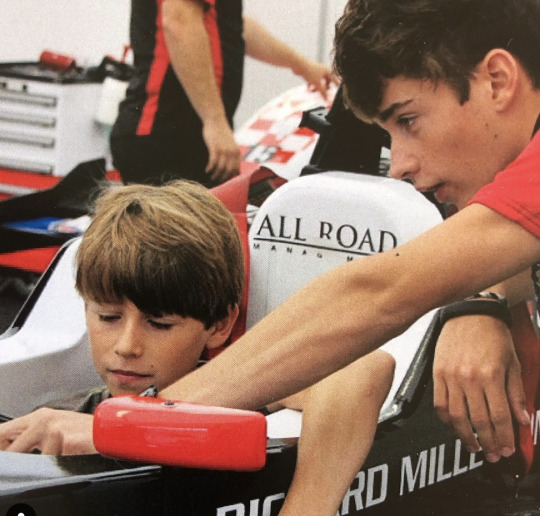
In a 2021 stream, Arthur expands on the difficulties:
"With my father I never traveled once. He didn't have the money for Charles' karting or for me. He did not have the money to go & see Charles in the race, actually. We were staying at home and following Charles in the computer."
(As a note, Charles would work with his uncle once he reached F1 to sponsor Arthur's career.)
In classic Charles fashion, he tried to put a positive spin on it in a 2020 interview:
"I have learned that from my father, who quite often left me alone on the race weekend so that I grew up on my own. I am trying to do the same with Arthur and so far he is doing a great job!"
The Leclerc family has a complicated history with racing: Hervé actually comes from a very successful Monaco family. His stepfather, Charles Manni, was the founder of a local company that manufactures car parts. Here is Hervé showing his F3 car to his stepfather:
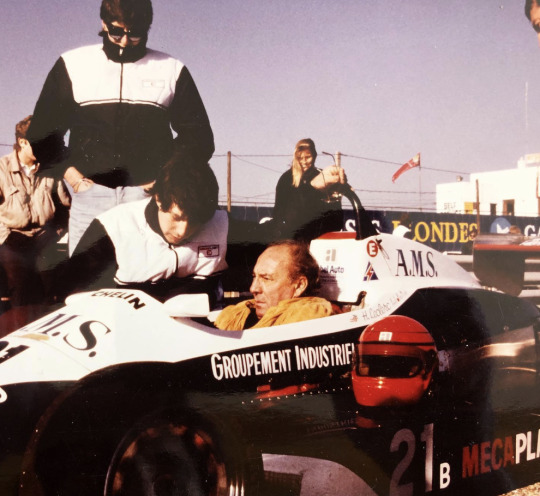
And Hervé with his half-brother (/Charles' uncle) Thierry Manni--
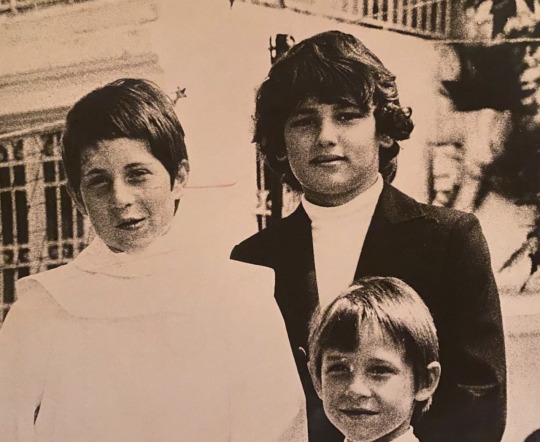
However... while Hervé and Thierry fell in love with racing, their father did not.
Thierry said:
"I often read that Charles comes from a modest family, but that's not true. We were the biggest employer in Monaco, but my father held on to a certain number of values. In the family, we do not write blank checks. He put limits on his participation, Hervé gave what he could and, at one point, we even found ourselves faced with an impasse. This is where Nicolas Todt intervened in 2011 to help us, under the leadership of Jules Bianchi. "
Once Charles' career appears to be in jeopardy, Jules-- Todt's first signed driver-- insists that they meet.
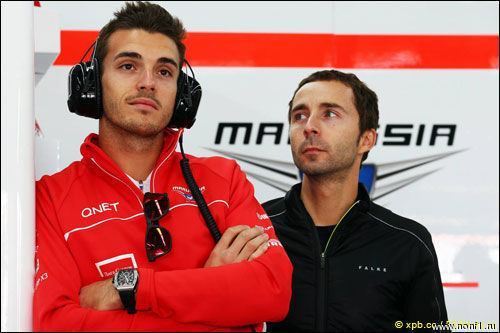
Todt is impressed by the karter, and steps in. Usually, a manager attempts to finance a driver through securing sponsorships; in Charles' case, Todt puts the money up himself.
In 2019, Todt says:
"I signed Charles at 14. He should have stopped karting because he ran out of money. I decided to help him. I introduced him to Ferrari a few years ago and today he drives there. And no one can say that he got there just like that: he's there because we did the job. For me, someone like Charles is my greatest pride, the fact that he went there and delivered."
Todt would later expand on this:
"I love finding future stars and helping them make their dreams come true. I am the only manager who does it that way, that is my specialty. It's easy to say: you have to do this, you have to do that. As long as it's not your own money, you can give advice. You can say 'buy this house'. But do you say: 'Buy this house, we make 50/50?' Then it's a completely different thing. If I believe in someone, then I invest. Of course, I also try to find sponsors who help me. But if I don't find sponsors, I'm the one who has to invest. I did that with Jules [Bianchi], I did it with Charles, and I do it with drivers who I think are special."
With Todt's support, Charles is able to compete in the Formula Renault 2.0 Alps Championship.
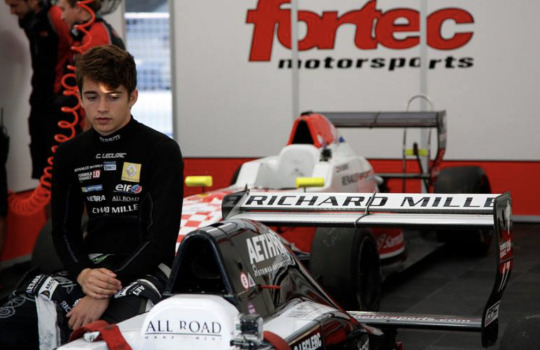
It is worth noting, though, that single-seaters weren't the only thing Charles learned to drive in 2014:
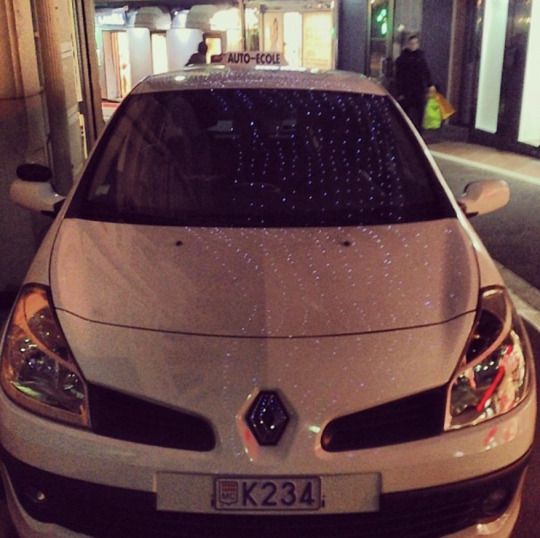

Charles starts his season off by picking his number... 17, which was also the number Jules was racing under in F1 at the time:
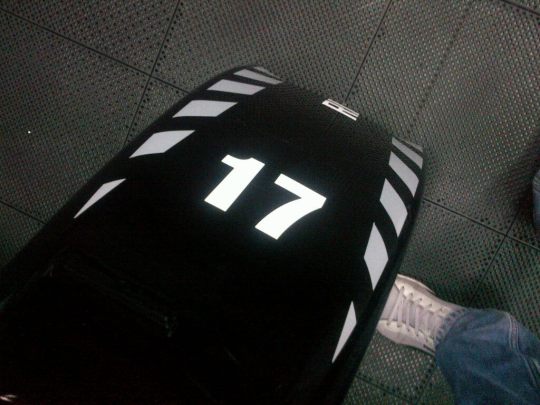

Charles starts the season strong. Charles manages to set a category track record at preseason testing: Kartcom's article summarizing the day was simply titled "Charles Leclerc leaves everyone in his trail in Barcelona".

Charles is quoted, saying:
"I don’t think the tests could have gone any better. It’s incredible being a rookie and setting the fastest overall time! We still have plenty of work to do, although I have learned a lot. Listening to the engineers is the key to making progress quickly. And although it’s nice to be quickest, it is still only testing. The races themselves will be a different matter."
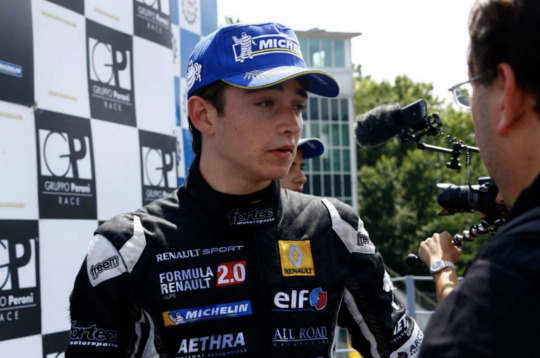
Jules sends out his well wishes for Charles' first race in Imola:

And Charles returns it:

Charles might be a rookie, but he impresses his team enough to where they run him in another series concurrently.
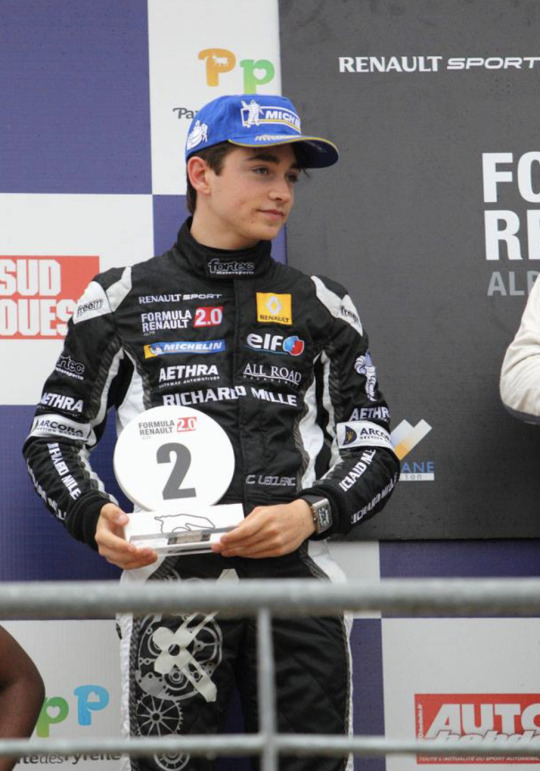
Formula Scout would summarize the season:
Leclerc entered Formula Renault 2.0 for his rookie single-season season, embarking on the Alps series for Fortec Motorsports. He quickly became a frontrunner, making the podium at round two at Pau and then twice again at Spa. At Monza he won both races, and followed that with more podiums to secure second place in the championship behind third-year FR2.0 racer Nyck de Vries. Some of Leclerc’s most impressive performances last year came in Eurocup Formula Renault 2.0 as a guest entry. He took part in six races and finished second in the last three of those, up against lots of drivers with multiple years of experience in the series.
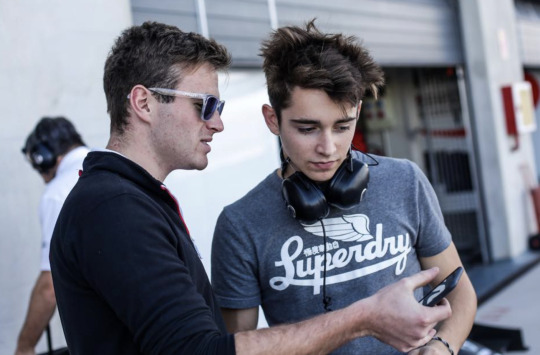
His first win single-seater win is in Monza, where he has a perfect weekend: he also wins that second race.
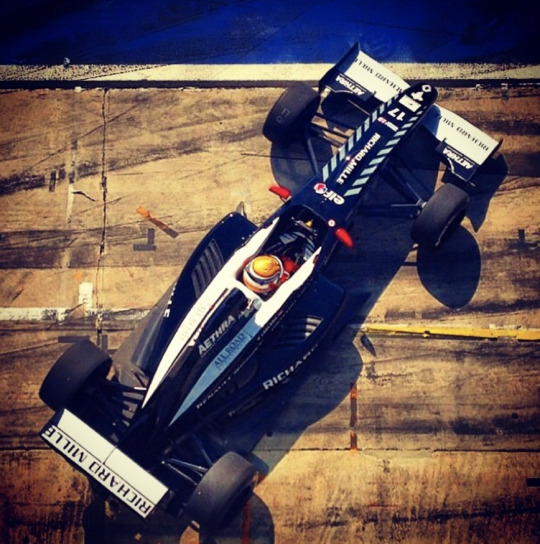
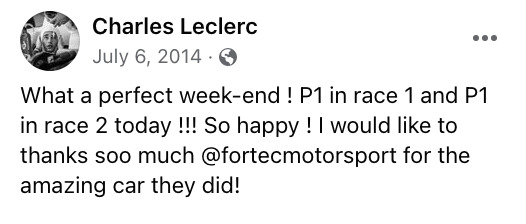
Of course, in true Charles fashion, he couldn't stop himself from a little self-criticism after the race:
"My start was not perfect and I’ve lost a place. Than I’ve managed to recover it duelling with Isaakyan. When my team told me of the 10” penalty assigned to Riener, I just focused in keeping my pace. This is a very special day as this is my first win ever in singleseaters."


Charles would finish the season with 199 points, 2 wins, 7 podiums and 1 pole position.


Formula Scout would summarize his performance:
After several starring years on the world karting scene, Leclerc’s car debut season was a long awaited one and it lived up to expectations. A non-score at the Imola opener aside, Leclerc delivered a superb rookie season, maturing and improving round after round, which culminated in a spectacular double victory at Monza and saw a further five podium appearances throughout the campaign. A protege of Nicolas Todt’s All Road Management firm, he has also been superb in his guest Eurocup outings and the chief 2.0 series appears to be a logical next step – one he’s more than ready for. In fact, it wouldn’t be a surprise to see him take a higher jump up the ladder than that.
They were right: Charles would take his old karting rival Max Verstappen's now open F3 seat at Van Amersfoort Racing for the 2015 season.
As a final note, this year was also very tragic: Jules' accident would happen in October, on the same day as Charles' final race in Formula Renault.
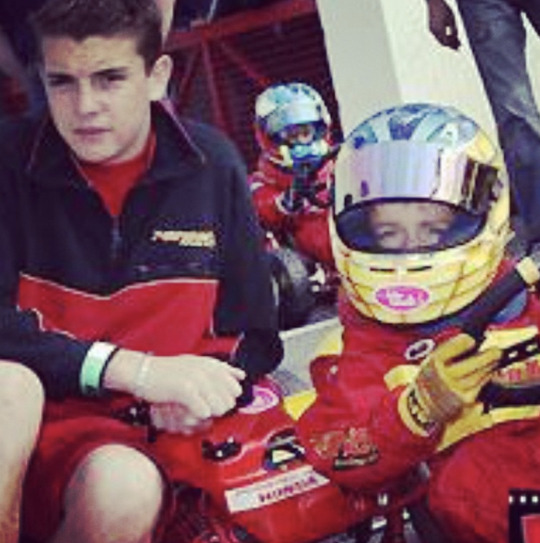

I'm not going to go into the details, because it feels like it would be disrespectful: it was a tragedy, and it very clearly deeply affected Charles and his family. Jules was an incredible influence for Charles, both personally and professionally.
Through all of this, however, Charles continues into Formula 3.
But that's for the next chapter.
126 notes
·
View notes
Text
Everything You Never Needed To Know About The Two Race Engine Rule (24-10-2007)
Context: Once upon a time, a driver could use three engines in the same day and simply risk a DNQ for not meeting the 107% rule. (Damon Hill, France 1999 qualifying day. Turns out that if one wishes to set a good time, one's has to do sufficient speedy laps on the track and not on stands in the garage). Then it was decided that was too wasteful and teams were banned from swapping engines between qualifying and the race. This was followed in 2005 with a requirement to use engines for two consecutive races before replacement, unless a race was not finished. In 2008, the requirement increased to 3 consecutive races on a single engine. I received a request to provide some statistics about the two-race engine era. Nowadays, each engine must last an average of 6 races, but teams can arrange that running how they want. A driver who wanted to do the first 3 and last 3 races on the same engine, but not any of the ones in between, is nowadays permitted to do so.
Thanks to neil for coming up with the idea for this entry, and especially to concentrate on the successes. To celebrate the fact that the two-race engine rule is now consigned to history, I will be doing some analysis of how the engine rules have influenced the grid.
Three seasons of careful management, impressive calculation and inopportune explosions will be celebrated in what I think is the most fitting way possible… …a ream of annotated statistics.
Victories Against The Odds
It has been mentioned in Autosport (March 23 2006 edition) that a new engine is worth 10-15hp over a used engine. Therefore, to win with a used engine suggests that the driver didn't have everything in their favour. And we all love drivers who win against the odds, don't we?
The following wins were achieved with a used engine:
2005
Fernando Alonso, Renault, Malaysia 2005 (the first time used engines appeared in a Grand Prix weekend was also the first time they won!) Fernando Alonso, Renault, San Marino 2005 Kimi Raikkonen, McLaren, Monaco 2005 Fernando Alonso, Renault, France 2005 Fernando Alonso, Renault, Germany 2005 Kimi Raikkonen, McLaren, Turkey 2005 (the start of a three-race chain) Juan Pablo Montoya, McLaren, Italy 2005 (the first time both drivers in the same team win at least one race with used engines - and consecutive ones to boot!) Kimi Raikkonen, McLaren, Belgium 2005 (this chain of three events, ending with this race, is the first time used engines win more than one race consecutively) Fernando Alonso, Renault, Brazil 2005
2005 used engine win total - 9 2005 new engine win total - 10
2006
Michael Schumacher, Ferrari, Europe 2006 Fernando Alonso, Renault, Spain 2006 Fernando Alonso, Renault, Britain 2006 Michael Schumacher, Ferrari, USA 2006 Michael Schumacher, Ferrari, Germany 2006 Felipe Massa, Ferrari, Turkey 2006 (first race to be won by someone with a used engine in two consecutive years) Michael Schumacher, Ferrari, Italy 2006 Fernando Alonso, Renault, Japan 2006 Felipe Massa, Ferrari, Brazil 2006
2006 used engine win total - 9 2006 new engine win total - 9
2007
Fernando Alonso, McLaren, Malaysia 2007 (first driver to have won the same event with used engines twice) Felipe Massa, Ferrari, Spain 2007 Lewis Hamilton, McLaren, Canada 2007 Kimi Raikkonen, Ferrari, France 2007 Fernando Alonso, McLaren, Germany 2007 (second driver to have won the same event with used engines twice) Felipe Massa, Ferrari, Hungary 2007 Fernando Alonso, McLaren, Belgium 2007 Kimi Raikkonen, Ferrari, Japan 2007
2007 used engine win total - 8 2007 new engine win total - 9
Grand total Used engines 25 v 29 New engines
Masters of Used Engines - Drivers
Fernando Alonso (11) Kimi Raikkonen (5) Felipe Massa (4) Michael Schumacher (3) Juan Pablo Montoya (1) Lewis Hamilton (1)
Fernando clearly takes the crown of Master of Used Engines. Admittedly, being in a championship-challenging car for three years in a row does help a little. That said, he is Master or Joint Master of Used Engines in each individual year as well (he shares with Michael Schumacher in 2006, and is the outright winner in both 2005 and 2007). This is quite a statement of skill.
Kimi Raikkonen would probably have done better had his engine been reasonably reliable in 2005 or 2006. Or indeed if he'd ever been on the top step of the podium in 2006. However, he plainly does not require a fresh engine to demonstrate his talent.
Felipe Massa is consistent, having two used-engine victories in both 2006 and 2007 (being in a non-victorious Sauber didn't help his 2005 rating much). Don't be surprised if he shows well in 2008's three-race engine environment.
Juan Pablo Montoya and Lewis Hamilton, in a sense, represent past and future. Juan Pablo used to be an exciting F1 driver. He's still exciting, but he's doing NASCAR now, where they don't mess about with multi-race engines as far as I'm aware. Since he's also refused to return to F1, don't expect him to add to this tally in any series.
If Lewis Hamilton doesn't add any used engine victories in the three-race engine era, then I'm an apple tree. The main reason why he's only had one win in this era is because he didn't compete in 2005 or 2006.
Two drivers have won a race with a new engine in this era without winning one with a used engine: Giancarlo Fisichella and Jenson Button. Jenson is not in the used engine winner list largely because his engine blew in free practise on the Saturday of Hungary 2006. Had it held on, he would a) have had an easier time of winning that race and b) be on the list.
Masters of Used Engines - Teams
Renault (8) McLaren (7) Ferrari (7)
The Masters of Used Engines team award has been hotly contested between three great teams - so hotly that no other team has a single used-engine victory to its credit.
Renault's position in the list is particularly remarkable, since only one driver contributed every single used-engine win to its effort. McLaren and Ferrari required three drivers to achieve their results.
All three of these teams won in two out of the three years the rule was in place.
Poles for Used Engines
Wins with an engine that is minus 10-15bhp are challenging, but what about carving perfect laps with imperfect engines? Surely that's got to be pretty tough.
2005
Fernando Alonso, Renault, Malaysia 2005 (again, first pole at first attempt for used engines) Kimi Raikkonen, McLaren, San Marino 2005 (first time a pole-sitting used-engine user didn't win the race pole was obtained in - that comes later for Kimi) Kimi Raikkonen, McLaren, Monaco 2005 (start of a three-race chain) Nick Heidfeld, Williams, Europe 2005 (first time a used engine is taken to pole by a driver who doesn't win a race with a used engine during the two-engined era) Jarno Trulli, Toyota, Canada 2005 (this three-race chain, ending this race, is the first time a used engine is on pole on consecutive occasions) Fernando Alonso, Renault, France 2005 Kimi Raikkonen, McLaren, Turkey 2005 Juan Pablo Montoya, McLaren, Belgium 2005
2005 used engine poles: 8 2005 new engine poles: 11
2006
Fernando Alonso, Renault, Monaco 2006 (first race where pole was obtained by someone with a used engine in two consecutive years) Michael Schumacher, Ferrari, USA 2006 Kimi Raikkonen, McLaren, Germany 2006 Felipe Massa, Ferrari, Turkey 2006 Felipe Massa, Ferrari, Brazil 2006
2006 used engine poles: 5 2006 new engine poles: 13
2007
Felipe Massa, Ferrari, Malaysia 2007 Felipe Massa, Ferrari, Spain 2007 Lewis Hamilton, McLaren, Canada 2007 Felipe Massa, Ferrari, France 2007 Kimi Raikkonen, McLaren, Germany 2007 (first driver to take pole with a used engine at the same race twice) Felipe Massa, Ferrari, Turkey 2007 (second driver to take pole with a used engine at the same race twice) Fernando Alonso, McLaren, Belgium 2007 Lewis Hamilton, McLaren, China 2007
2007 used engine poles: 8 2007 new engine poles: 9
Grand total Used engines 21 v 33 new engines
Clearly new engines are a more significant factor in qualifying than in the race. This was especially the case in 2006, where developments were being completed quickly in anticipation of the 2007 engine homologation rules. Notice that in 2007, new and used engines are more evenly matched in qualifying.
Kings of Used Engine Speed - Drivers
Felipe Massa (6) Kimi Raikonnen (5) Fernando Alonso (4) Lewis Hamilton (2) Nick Heidfeld (1) Jarno Trulli (1) Juan Pablo Montoya (1) Michael Schumacher (1)
There is a lot more competition for this contest than the Master of Used Engines award. The winner of the award is Felipe Massa. He appears to be an expert at teasing speed out of a used engine when qualifying comes around. He was better at it than Michael Schumacher in 2006, and he has held his own in 2007. Very impressive, especially in this era when the pole-sitter often goes on to win.
Kimi Raikkonen's moments of brilliance are more spread out, but you can count on there being at least one in each season. Unfortunately, the poles rarely led to victories (his used-engine victories tended to be born in the adversity of second-row starts - or worse).
Fernando Alonso is a much better racer than he is a qualifier. That said, he won the world championship in 2006 without getting one pole with a used engine, so maybe there's a lesson in that for his rivals…
Lewis Hamilton is, in theory, a better qualifier than racer on used engines. That said, with such a small sample it's difficult to tell.
Michael Schumacher seemed to need a new engine in order to get pole. That didn't stop him from being at the sharp end of the grid a lot of the time, though.
Nick Heidfeld and Jarno Trulli never won a race in the two-engine era despite both getting poles with used engines - surely indicating that both qualify better than they race. While this probably isn't news to Trulli observers, those who observe Heidfeld tend not to mention this when writing about him.
Juan Pablo Montoya's single pole with a used engine is probably because he got most of his poles before the rule was introduced. Qualifying used to be a speciality of his.
Kings of Used Engine Speed - Teams
Ferrari (10) McLaren (7) Renault (3) Williams (1) Toyota (1)
The titans in the 2007 championship fight are the ones that are at the head of this list. That said, the clear Masters of Used Engine Speed are Ferrari, largely because Felipe Massa has driven so many pole laps for them. It's almost as if he needs a used engine before he fully lets himself go. That said, Kimi Raikkonen has also found the Ferrari environment conducive to his natural abilities. Even Michael managed to get pole with a used engine once…
McLaren despite having had four drivers help them get their total, are definitely behind Ferrari. This is largely because none of their drivers got consistent poles in the first place (they kept getting let down by their machinery, then polemeisters Massa and Raikkonen got together at the red team).
Renault can credit their entire presence on this list to Fernando Alonso. Williams and Toyota likewise only had one driver contribute to their totals.
The "It'll Be All Right On The Night" Award for Reliability - Engine Suppliers
BMW (1.67/car/year, 5 total) <1 in Williams; 3 + 1 in BMW Sauber> Renault (1.75/car/year, 7 total) <2 + 2 + 2 in Renault; 1 in Red Bull> Ferrari (3.43/car/year, 24 total) <4 + 8 + 1 in Ferrari; 3 in Sauber; 3 in Red Bull; 0 in Toro Rosso; 5 in Spyker> Toyota (3.5/car/year, 21 total) <1 + 8 + 0 in Toyota; 5 + 3 in Jordan/Midland/Spyker; 4 in Williams> Mercedes (3.67/car/year, 11 total) <8 + 2 + 1 in McLaren> Cosworth (3.75/car/year, 15 total) <1 in Red Bull; 2 + 4 in Minardi/Toro Rosso; 8 in Williams> Honda (4,25/car/year, 21 total) <5 + 8 + 3 in BAR/Honda; 2 + 3 in Super Aguri>
The BMW engines are most likely to be "all right on the night", with Renault closely following. This is a significant factor into both team's successes during the two-engine era - BMW's improvement was helped because it could chase up pesky gearboxes and speed instead of engines. Renault's tendency to stay in one piece helped Fernando Alonso's championship campaigns considerably. Renault is statistically the best engine on offer to customers - lucky Red Bull for having that supply!
There is a large gap to the next engine supplier, then you reach Ferrari. In its own cars the engines have worked quite unreliably until the homologation rules kicked in. That said, three of the eight failures in the works team happened to Felipe Massa during the Malaysian GP weekend, which reduced the pain somewhat. For that matter, apart from Spyker, all its customers got more reliable units than the works team. Maybe the customer engines were slower, but at least the teams could depend on Ferrari to clear out some of the bugs that appear to be inherent in Ferrari engine design.
Toyota is slightly worse than Ferrari, much of which can be attributed to an atrocious run of unreliability in 2006. In general, the customer units do not appear to have had many of the reliability flaws removed - not a good sign, since this means progress is relatively slow.
For all Mercedes developed a lousy reputation for reliability, this would appear to only be justified for 2005. However, eight failures in a year when no other works team had half that many said a lot. Since then, it is clear that lots of effort has been made to send out working units to the drivers, which has been particularly helpful in 2007.
Cosworth was the customer of last resort, which may go some way towards explaining its poor record. Integration into teams was not very high, simply because teams expected to be using another engine as soon as possible and therefore didn't work so well with the engine supplier. Though it is true that lack of money didn't help.
Honda should be embarrassed. Clearly it can send a reasonably reliable unit to customers (as Super Aguri can happily testify), so why can't it send something functional to its own works drivers? No wonder Button and Barrichello look like pulling their hair out at times…
The "It'll Be All Right On The Night" Award for Reliability - Teams
Red Bull (5) Super Aguri (5, across two seasons only) Renault (6) Minardi/Toro Rosso (6) (BMW) Sauber (7) Toyota (9) McLaren (11) Williams (13) Jordan/Midland/Spyker (13) Ferrari (13) BAR/Honda (16)
For the most part, customer teams had more reliable engines than their works providers. The exceptions are Williams and Spyker, who have chopped and changed a lot. Integration, or lack of same, explains their woes quite eloquently.
5 notes
·
View notes
Text
10 Popular Courses in France For Indian Students in 2025
Many Indian students choose France for its outstanding education, global opportunities and lively culture. Because the country has some of the best colleges, low tuition rates and focuses on research and development, France is increasingly popular among international students.
In the coming years, more Indian students may enroll in French universities because these programs stand out in a global market and are valued around the world. You can find courses in management, fashion, engineering and data science, among others, in France.
Here are the 10 most popular courses in France for Indian students in 2025:
1. Business and Management
Enriched with knowledge and experience, HEC Paris, INSEAD, ESCP Business School and EDHEC Business School are top business schools in France. Students from India often go to France for its leading MBA and master’s courses in business fields that include international business, marketing, finance and entrepreneurship.
Why it’s popular:
Strong industry-academia links.
Opportunities for internships and job placements.
Affordable MBA options compared to the US or UK.
Multinational companies like L’Oréal, BNP Paribas, and Renault headquartered in France.
Top Institutions:
HEC Paris
ESSEC Business School
Grenoble Ecole de Management
2. Engineering and Technology
Many Indian students still choose engineering and French Grandes Écoles and technical universities provide excellent programs in branches such as mechanical, electrical, civil, aerospace and computer science engineering.
France is a world leader in the development of new technologies for aerospace, automotive and energy industries. Airbus, Dassault Systems and Alstom are accessible to Indian students, who also benefit from the latest facilities and chances to do research.
Why it’s popular:
Research-intensive curriculum.
Availability of English-taught programs.
High ROI due to affordable fees and strong placement networks.
Top Institutions:
École Polytechnique
CentraleSupélec
IMT Atlantique
3. Fashion and Luxury Brand Management
Fashion, luxury and design are all based in France. Popular fashion houses such as Chanel, Louis Vuitton, Dior and Hermès call cities like Paris home. If you want to study fashion design, luxury management and how brands are developed, France is a good choice.
Why it’s popular:
Direct exposure to the fashion industry.
Internships and networking with major luxury brands.
Programs that combine creativity with business acumen.
Top Institutions:
Institut Français de la Mode (IFM
ESMOD Internationa
SKEMA Business School (for luxury brand management)
4. Hospitality and Tourism Management
Because France is the most popular tourist destination, studying hospitality and tourism management there is an excellent choice. Hospitality has a widespread presence globally, provides solid training and Indian students can apply in the top-ranked institutions.
Why it’s popular:
Strong practical training component.
Internship opportunities with leading hotel chains.
Career prospects in global hospitality brands.
Top Institutions:
Vatel International Business School
Institut Paul Bocuse
Ferrandi Paris
5. Data Science and Artificial Intelligence
Because of how important big data, AI and machine learning are lately, France has established certain programs to support demand from the industry. Many Indian students in engineering and computer science are now applying to these course programs.
Why it’s popular:
English-taught master's programs.
Collaboration with tech companies and research labs.
High employability in France and abroad.
Top Institutions:
Télécom Paris
ENSAI (École Nationale de la Statistique et de l’Analyse de l’Information)
Université PSL (Paris Sciences et Lettres)
6. International Relations and Political Science
France has been involved in diplomacy and international politics for many years. Indian students interested in relations between countries pick France for its programs in international relations, European studies and political science.
Why it’s popular:
Focus on global political systems and European Union studies.
Access to internships at global organizations like UNESCO and OECD.
Multi-cultural classrooms that enhance global perspectives.
Top Institutions:
Sciences Po
EHESS (École des Hautes Études en Sciences Sociales)
Université Paris 1 Panthéon-Sorbonne
7. Environmental Science and Sustainability
The country has strongly promoted environmental care and the development of green technology. Students pursuing careers in climate change, sustainable development and environmental policy in India will come across several programs suited to their needs.
Why it’s popular:
Rising demand for sustainability experts globally.
Research-based courses with a practical orientation.
Exposure to EU sustainability policies and green initiatives.
Top Institutions:
Université Grenoble Alpes
AgroParisTech
École des Ponts ParisTech
8. Culinary Arts and Gastronomy
People believe French cuisine is among the best in the world. Any Indian student dreaming of becoming a chef can also study in well-known French culinary schools and work with Michelin-star chefs.
Why it’s popular:
Immersive hands-on learning.
Strong global recognition of French culinary schools.
Opportunities to work in elite restaurants and hotels.
Top Institutions:
Le Cordon Bleu Paris
Ferrandi Paris
École Ducasse
9. Architecture and Urban Planning
The many well-preserved cities and cutting-edge infrastructure in France attract architecture and urban planning students. They have the opportunity to learn about traditional European fashion and modern houses and at the same time develop the necessary skills of their trade.
Why it’s popular:
Blend of history, theory, and practice.
Architectural tours and design workshops.
Global recognition of French architectural degrees.
Top Institutions:
ENSA (Écoles Nationales Supérieures d'Architecture)
École Spéciale d’Architecture
Paris School of Architecture
10. Health and Life Sciences
There is a strong emphasis on both hospital care and medical advances in France. Many Indian students are choosing to study biotechnology, pharmacology, public health and life sciences.
Why it’s popular:
High-quality research infrastructure.
Collaborations with global pharmaceutical companies.
Opportunities in healthcare innovation and policy.
Top Institutions:
Université de Paris
Université Claude Bernard Lyon 1
Institut Pasteur
Why Indian Students Prefer France in 2025
Here are some reasons why Indian students are choosing France more than ever before:
1. Affordable Education
French public universities offer low or no tuition fees for EU and international students. Even in private institutions, the cost is often lower than in the US or UK.
2. Availability of English-Taught Programs
More than 1,500 programs are now offered in English across different disciplines, making it easier for Indian students who may not be fluent in French.
3. Stay Back and Work Opportunities
Post-study work visas and support for entrepreneurship have made it more attractive for Indian graduates to stay and build their careers in France.
4. Vibrant Indian Student Community
France hosts more than 10,000 Indian students annually, supported by Indian student associations, embassy initiatives, and alumni networks.
5. Cultural Diversity
Studying in France allows Indian students to explore a rich cultural history, multilingual environments, and globally relevant career opportunities.
Final Thoughts
In France, students from India will find top schools, a rich culture and plenty of job opportunities. There are plenty of business, fashion, technology and culinary arts courses in France designed to help you succeed worldwide.
Since small tuition fees, top schools and a welcoming atmosphere await international students, Indian youth should consider France their first choice to study in 2025.
Cliftons Study Abroad can assist you from the beginning, offering support with counseling, picking the right course, obtaining a visa and arranging everything else.
Looking to study in France in 2025? Contact Cliftons Study Abroad today and take the first step toward your international education dream!
#study abroad#study in uk#study abroad consultants#study in germany#study in australia#study in ireland#study blog
0 notes
Text
Smart Parts Exports: Your Trusted Renault Spare Parts Exporter
When it comes to sourcing standard Renault Spare Parts Exporter, discovering a reliable Renault parts exporter is significant. Whether you are a carry on with, wholesaler, or retailer, purchasing genuine Renault ingredients is required to continue to up the presentation and longevity of Renault vehicles. This blog explores the weightiness of smart parts exports for Renault, their advantages, and how to realize the unmatched Renault OEM parts exporter.
The Importance of Genuine Renault Spare Parts
Renault is one of the the majority powerful automobile factory freeholders in the world, well known for its innovative designs, highly developed engineering, with superior performance.Like a lot of other vehicles, Renault cars have mandatory routine maintenance and timely replacements to function at their best. employ original Renault spare parts corroborate:
Optimal Performance: Genuine Renault parts are designed to pertinent and function to perfection with Renault vehicles, ensuring smooth operation.
Longevity: High-character parts last longer, reducing the frequency of replacements.
Safety: Using OEM parts guarantees safety, as they meet Renault’s strict quality standards.
Warranty Compliance: Many manufacturers offer warranties that remain valid only if OEM parts are used.
Why Choose a Renault OEM Parts Exporter?
A Renault OEM parts exporter specializes in on the assumption that untouched equipment manufacturer (OEM) parts to universal markets. These parts are directly sourced from Renault or its authorized constructor, ensuring originality as well as reliability. Here’s why partnering with a Renault OEM parts exporter is of assistance:
Guaranteed Quality: OEM parts are manufactured to ask for specifications, set the seal on an explicit fit.
Enhanced Durability: Renault OEM parts are built using high-quality medium, making them more indestructible than aftermarket alternatives.
Better presentation: Since these parts are designed specifically for Renault vehicles, they provide superior performance and efficiency.
Cost Efficiency in the Long Run: While OEM parts might be slightly more expensive upfront, they save money in the long run by reducing repair and replacement costs
Renault Spare Parts Components: What’s Available?
When looking for a Renault spare parts exporter, it’s essential to understand the range of components available. Some of the most commonly exported Renault spare parts include:
1. Engine Components
Cylinder heads
Pistons
Camshafts
Oil filters
Timing belts
2. Transmission Parts
Gearboxes
Clutch kits
Drive shafts
Differentials
3. Braking System
Brake pads
Brake discs
Master cylinders
Brake calipers
4. Suspension and Steering
Shock absorbers
Control arms
Tie rods
Steering racks
5. Electrical and Electronic Components
Alternators
Starter motors
Ignition coils
Sensors and control modules
6. Body and Interior Parts

Bumpers
Headlights and taillights
Side mirrors
Seats and dashboard components
Finding a Reliable Renault Spare Parts Exporter
Selecting the proper Renault spare parts exporter is unfavorable to ensuring you receive high-quality, genuine elements. Here are some tips to help you observe the best supplier:
1. Check for Certifications
Ensure the exporter is certified and authorized to supply Renault spare parts. This guarantees the authenticity and quality of the parts.
2. Evaluate Their Product Range
A reputable Renault parts exporter should have a comprehensive inventory covering all essential components for various Renault models.
3. Assess Their Logistics and Shipping Capabilities
Efficient shipping and logistics are crucial for a smooth export process. Ensure the supplier has a well-established distribution network and can deliver parts promptly.
4. Compare Prices and Warranty Offers
While pricing is essential, don’t compromise on quality. Look for an exporter who offers competitive prices along with warranty protection.
5. Check Customer Reviews and Reputation
Research customer feedback and industry reputation to ensure you’re dealing with a trusted Renault spare parts exporter.
The Future of Renault Parts Export
With the automotive industry evolving rapidly, the pressure for smart parts exports is increasing. The production of digital platforms in the spare parts supply chain is making it easier for businesses to source Renault Spare Parts components. Some future trends include:
Online Marketplaces: More exporters are leveraging e-commerce platforms for easier access to Renault spare parts.
AI-Powered Inventory Management: newly discovered AI tools are helping exporters trail stock levels as well as envision pressure.
Sustainable Practices: Eco-friendly packaging as well as recycling initiatives are becoming repeated in the auto parts steadiness
Conclusion
Whether you are a business landowner or a technician looking for reliable Renault Spare Parts components, authenticating your genuine Renault spare parts is crucial. A truthful Renault OEM parts exporter provides high-quality, strongly made, and presentation-enhancing elements that keep Renault vehicles administered smoothly. By choosing a devoted Renault spare parts exporter, you can guarantee the best value and presentation for your customers. Invest in smart parts exports today and experience the benefits of genuine Renault spare parts!
#Renault parts exporter#Renault OEM parts exporter#Renault spare parts exporter#Renault Spare Parts components
0 notes
Text
Renault Master rent a car Satu Mare
Renault Master – Space, Reliability and Affordable Prices at Rentsilvania Satu Mare!
Are you looking for a van you can rely on? At Rentsilvania rent a car Satu Mare we have the ideal solution:
✅ Renault Master 2013
Dimensions: L2H2 Volume: 11 m³ Engine: Diesel 2.3L Price: from €49/day
✅ Renault Master 2016
Dimensions: L3H2 Volume: 13 m³ Engine: Diesel 2.3L Price: from €59/day
Ideal for transporting goods or your projects! Book online now or visit us at our Satu Mare office.
0 notes
Text
Global Renault OEM Parts Supplier: Unmatched Quality and Reliability

Selecting a Renault OEM parts exporter is crucial for preserving the longevity, economy, and performance of your Renault car. In order to guarantee a flawless fit and unwavering quality, Original Equipment Manufacturer (OEM) components are created especially to satisfy the exact specifications of Renault automobiles. We take pride in being a reputable brand in the business at Smart Parts Exports, providing authentic Renault OEM parts to clients all over the world. Both corporations and individual customers may easily obtain the parts they require thanks to our vast inventory, affordable prices, and worldwide delivery capabilities.
Why Choose Renault OEM Parts?
Renault OEM parts are crafted with precision and adhere to the highest quality standards set by the manufacturer. Unlike aftermarket alternatives, these parts guarantee:
Perfect Compatibility: Renault OEM parts are designed specifically for your vehicle’s make and model, ensuring a seamless fit and optimal performance.
Superior Quality: Using genuine parts maintains your vehicle’s integrity, enhancing its durability and safety.
Manufacturer Warranty: OEM parts often come with warranties that protect your investment, providing peace of mind.
Enhanced Resale Value: Maintaining your vehicle with original parts increases its resale value, as potential buyers prefer well-maintained cars.
Smart Parts Exports is committed to making genuine Renault parts available to clients worldwide since we recognize how crucial it is to provide them in order to satisfy their requirements.
Smart Parts Exports: Your Reliable Partner for Renault OEM Parts
Our specialty at Smart components Exports is exporting authentic Renault components to meet a variety of customer needs. Regardless of your role—workshop owner, reseller, or person seeking particular parts—our all-inclusive services guarantee that you get the best answers. We are the preferred exporter of Renault OEM parts for many clients for the following reasons:
Extensive Inventory: Our stock includes everything from engine components and brake systems to electrical parts and body panels, all sourced directly from Renault.
Global Shipping: With a robust logistics network, we deliver parts to over 50 countries, ensuring timely and secure deliveries.
Competitive Pricing: By leveraging strong supplier relationships, we offer OEM parts at highly competitive rates without compromising on quality.
Customer Support: Our dedicated team provides personalized assistance, helping you find the exact parts you need and answering any queries promptly.
Key Renault Parts Available at Smart Parts Exports
We pride ourselves on offering a wide range of Renault OEM parts to cater to the diverse requirements of our customers. Some of our top-selling categories include:
Engine Components: Pistons, cylinders, crankshafts, and timing belts.
Suspension and Steering Systems: Shock absorbers, control arms, and steering racks.
Brake Systems: Brake pads, rotors, calipers, and master cylinders.
Electrical Parts: Alternators, starters, and wiring harnesses.
Body Panels: Bumpers, fenders, and doors.
Cooling Systems: Radiators, thermostats, and water pumps.
All these parts come with a guarantee of authenticity and are rigorously inspected to meet Renault’s strict quality standards.

Why OEM Parts Matter for Renault Vehicles
Renault automobiles are renowned for their cutting-edge design and engineering. It is essential to use parts that fulfill the manufacturer's specifications in order to preserve these attributes. Using inferior or fake parts may result in:
Reduced Performance: Aftermarket parts may not provide the same level of efficiency, affecting your vehicle’s performance.
Safety Risks: Inferior parts can compromise your vehicle’s safety features, putting you and others at risk.
Higher Long-Term Costs: Cheap alternatives often wear out faster, leading to frequent replacements and higher maintenance costs.
By sourcing genuine parts from a reliable Renault OEM parts exporter like Smart Parts Exports, you ensure the best care for your vehicle.
How to Order Renault OEM Parts from Smart Parts Exports
Placing an order with Smart Parts Exports is simple and hassle-free. Follow these steps:
Browse Our Catalog: Explore our extensive range of Renault parts on our website.
Request a Quote: Provide details about the parts you need, including part numbers if available.
Confirm Your Order: Once you receive a competitive quote, confirm your order and provide shipping details.
Receive Your Parts: Sit back and relax as we ensure timely delivery to your location, anywhere in the world.
Partner with the Best Renault OEM Parts Exporter
Smart Parts Exports is dedicated to offering top-notch Renault parts along with first-rate customer support. We can manage orders of any size, regardless of whether you're searching for a single component or want large numbers. Our goal is to provide genuine OEM components to help consumers and companies maintain the dependability and performance of Renault cars.
Contact us or visit our website at www.smartpartsexports.com to find out more about what we have to offer. For all of your Renault OEM parts needs, rely on Smart Parts Exports as your trustworthy partner!
0 notes
Text
Read/Write CONTINENTAL SID310 ECU with 4 Tools
Here are some good ECU Programmers that support CONTINENTAL SID310 reading and writing:
Xhorse MultiProg, CG FC200, Alientech Kess3, Hexprog II.
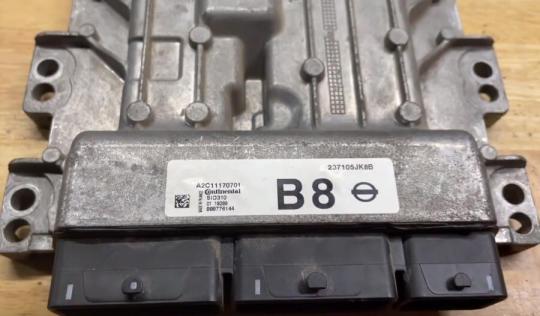
1.Xhorse Multi-prog(Boot mode)
Price: €755 (EU/UK Ship No Tax free shipping)
Support Dacia, Renault, Opel, and Nissan SID310 EC
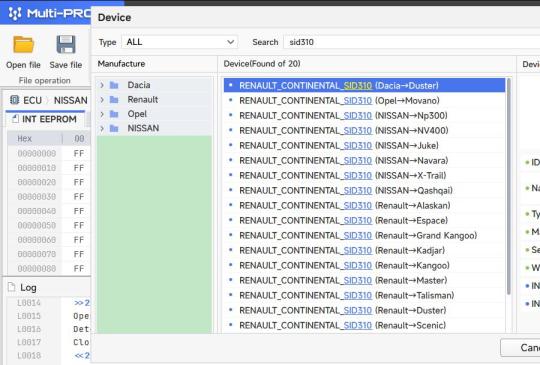

Multi-prog is available with English, Chinese. It has built-in update software, and supports free update online frequently.
Bonus function:
Built-in Script function
Support self-test and smart operation mode
Get free BMW ISN read function and NEC, MPC, Infineon, etc chip continuously update service
With free MQB48 license. Bind Multi-prog to VVDI2 full version or key tool plus to the same Xhorse app account to use MQB48 NEC35XX function.
Add VAG MQB RH850 dashboard processor(need separate RH850 cable for multiprog)
It can offer you the wiring diagram and which adapter is required to work with (click Detail after selecting the ECU type), and the user manual (click Help>> Help documents) in the Multi-Prog software.
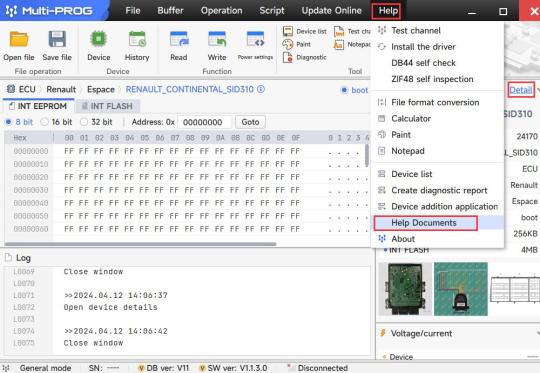
2.CG FC-200 (Boot mode)
Price: €574 (EU Ship No Tax Free Shipping)
Support continental TC17 type engine computers SID310 (require software V1.1.6.0 or above)
FC200 is available in English and French, for Spanish, Polish, Turkish, and Traditional Chinese, you need to pay $150 for authorization. It supports free update online for one year (Annual fee will be €200/year after the first year)
It also has the wiring diagram in the software for reference.

Bonus function:
Read for BMW ISN Code by OBD
Support BOSCH MPC5xx platform mode ECU: MED9.1, MED9.5, MED9.5.10, ME9.0, EDC16CP31, EDC16CP35, EDC16C2, EDC16C8 (Need to buy extra FC200 MPC5XX Adapter)
Support GM E38, E39, E67 ECU, ZF 9HP Gearbox, etc.
3.Alientech Kess V3 (OBD and Boot modes)
Price: €779 (EU Ship No Tax Free Shipping)
Need to buy KESS3 software license separately
Focus on Dacia, Infiniti, Nissan, Opel, and Renault Continental SID310 ECU
Kess V3 supports multi-language and one year subscription for free upon activation. It has a Slave and Master version, and supports upgradable from Slave to Master. It can work with some existing KESS V2 cables for old models. Working with the unique Alientech Suite software, it’s super fast to read, write and calculate checksum for car, motorcycle, truck/tractor, agricultural and marine with separate protocols.
It needs to read ECU Password via OBD Protocol, and read/write ECU in boot mode.

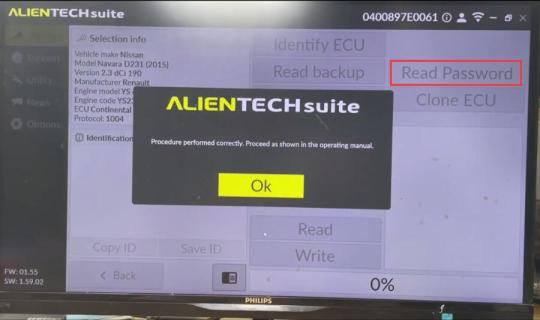

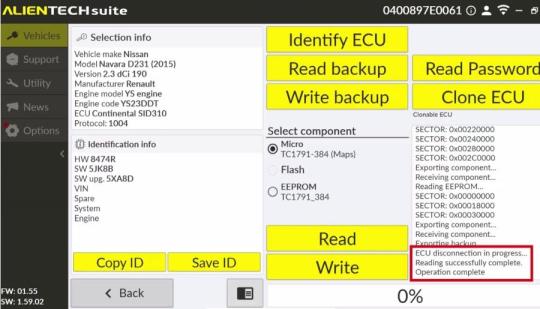
Kess V3 Continental SID310 ECU Support List:
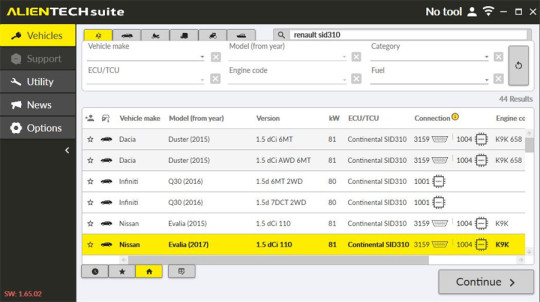


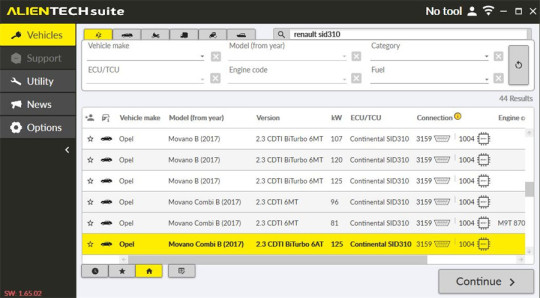
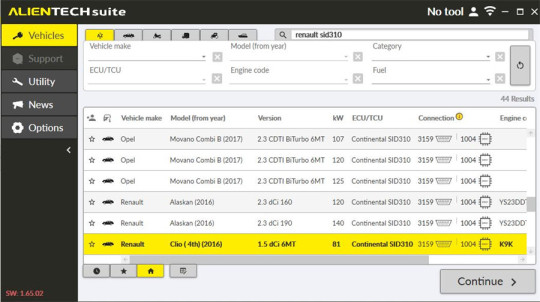
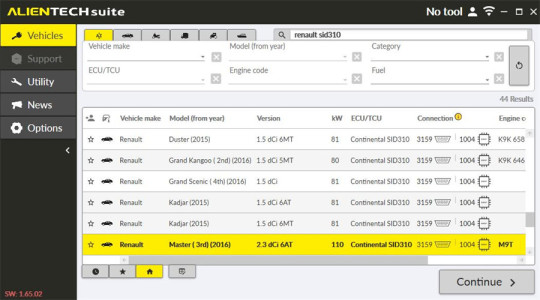
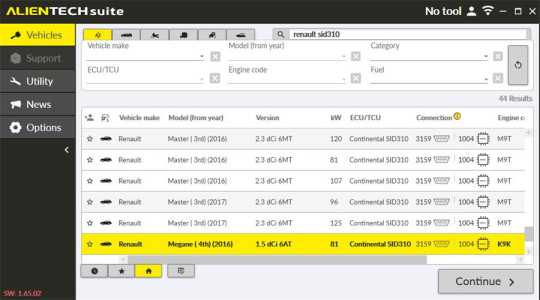

4.Hexprog II (Bench and Boot modes)
Price: $575.00 (basic set)
Hexprog II supports Bench Mode for Mercedes Benz and Infiniti vehicles, eliminating the need to physically open the ECU. Through ECU programming, users can clone and modify the ECUs, including Chip Tuning for enhanced performance.
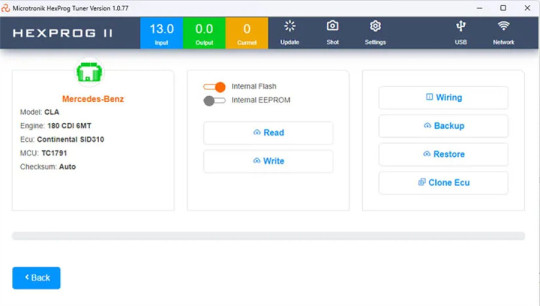
To perform tasks such as ECU Repair, ECU Cloning, or read-write operations on the SID310 ECU, it is necessary to retrieve the OBD password from the respective vehicles of Nissan, Renault, Dacia, or Opel. In Hexprog II Tuner software, there is an option available to retrieve this OBD password, but it can only be done in boot mode due to the enhanced security of the ECU.

In addition, other China ECU clones like Foxflash, PCMtuner, Kess V2, and KT200 also can read/write CONTINENTAL SID310 well.
However, it’s recommended to use the original ECU programmer to ensure high quality and good after-sale service. Multi Prog and FC200 is more cost-effective to choose, and Kess V3 supports the most protocols but it's more expensive. Not one tool supports everything! You can have one or more tools depending on your need.
0 notes
Text
The automotive industry comprises a wide range of companies and organizations involved in the design, development, manufacturing, marketing, selling, repairing, and modification of motor vehicles. It is one of the world's largest industries by revenue.The word automotive comes from the Greek autos (self), and Latin motivus (of motion), referring to any form of self-powered vehicle. This term, as proposed by Elmer Sperry.First came into use with reference to automobiles in 1898.
History:
The automotive industry began in the 1860s with hundreds of manufacturers pioneering the horseless carriage. Early car manufacturing involved manual assembly by a human worker. The process evolved from engineers working on a stationary car, to a conveyor belt system where the car passed through multiple stations of more specialized engineers. Starting in the 1960s, robotic equipment was introduced to the process, and today most cars are produced largely with automated machinery.
For many decades, the United States led the world in total automobile production, with the U.S. Big Three General Motors, Ford Motor Company and Chrysler being the world's three largest auto manufacturers for a time, and G.M. and Ford remaining the two largest until mid-2000s. In 1929, before the Great Depression, the world had 32,028,500 automobiles in use, of which more than 90% produced by the U.S. automobile industry. At that time, the U.S. had one car per 4.87 persons.
Notable company relationships:
Daihatsu holds a 25% stake in Perodua.
Daimler holds a 10.0% stake in KAMAZ.
Daimler holds an 89.29% stake in Mitsubishi Fuso Truck and Bus Corporation.
Daimler holds a 3.1% in the Renault-Nissan Alliance, while Renault-Nissan Alliance holds a 3.1% share in Daimler AG.
Daimler holds a 12% stake in BAIC Group, while BAIC Group holds 5% stake in Daimler.
Daimler holds an 85% stake in Master Motors.
Dongfeng Motor holds a 12.23% stake and a 19.94% exercisable voting rights in PSA Groupe.
FAW Group owns 49% of Haima Automobile.
FCA holds a 10% stake in Ferrari.
FCA holds a 67% stake in Fiat Automobili Srbija.
FCA holds 37.8% of Tofaş with another 37.8% owned by Koç Holding.
1 note
·
View note
Text
Underground, Part 1
[Author’s Note: A year ago, when waiting for the DC Metro, I came up with an idea for a short story involving two realtors and the infamous Las Vegas Underground House, typed up an outline, and shoved it away in my documents where it sat neglected until this month. The house recently resurfaced on Twitter, and combined with almost a year of quarantine, the story quickly materialized. Though I rarely write fiction, I decided I’d give it a shot as a kind of novelty McMansion Hell post. I’ve peppered the story with photos from the house to break up the walls of text. Hopefully you find it entertaining. I look forward to returning next month with the second installment of this as well as our regularly scheduled McMansion content. Happy New Year!
Warning: there’s lots of swearing in this.]
Underground

Back in 1997, Mathieu Rino, the son of two Finnish mechanical engineers who may or may not have worked intimately with the US State Department, changed his name to Jay Renault in order to sell more houses. It worked wonders.
He gets out of the car, shuts the door harder than he should. Renault wrinkles his nose. It’s a miserable Las Vegas afternoon - a sizzling, dry heat pools in ripples above the asphalt. The desert is a place that is full of interesting and diverse forms of life, but Jay’s the kind of American who sees it all as empty square-footage. He frowns at the dirt dusting up his alligator-skin loafers but then remembers that every lot, after all, has potential. Renault wipes the sweat from his leathery face, slicks back his stringy blond hair and adjusts the aviators on the bridge of his nose. The Breitling diving watch crowding his wrist looks especially big in the afternoon glare. He glances at it.
“Shit,” he says. The door on the other side of the car closes, as though in response.
If Jay Renault is the consummate rich, out-of-touch Gen-Xer trying to sell houses to other rich, out-of-touch Gen-Xers, then Robert Little is his millennial counterpart. Both are very good at their jobs. Robert adjusts his tie in the reflection of the Porsche window, purses his lips. He’s Vegas-showman attractive, with dark hair, a decent tan, and a too-bright smile - the kind of attractive that ruins marriages but makes for an excellent divorcee. Mildly sleazy.
“Help me with these platters, will you?” Renault gestures, popping the trunk. Robert does not want to sweat too much before an open house, but he obliges anyway. They’re both wearing suits. The heat is unbearable. A spread of charcuterie in one hand, Jay double-checks his pockets for the house keys, presses the button that locks his car.
Both men sigh, and their eyes slowly trail up to the little stucco house sitting smack dab in the center of an enormous lot, a sea of gravel punctuated by a few sickly palms. The house has the distinct appearance of being made of cardboard, ticky-tacky, a show prop. Burnt orange awnings don its narrow windows, which somehow makes it look even more fake.
“Here we go again,” Jay mutters, fishing the keys out of his pocket. He jiggles them until the splintered plywood door opens with a croak, revealing a dark and drab interior – dusty, even though the cleaners were here yesterday. Robert kicks the door shut with his foot behind him.
“Christ,” he swears, eyes trailing over the terrible ecru sponge paint adorning the walls. “This shit is so bleak.”
The surface-level house is mostly empty. There’s nothing for them to see or attend to there, and so the men step through a narrow hallway at the end of which is an elevator. They could take the stairs, but don’t want to risk it with the platters. After all, they were quite expensive. Renault elbows the button and the doors part.
“Let’s just get this over with,” he says as they step inside. The fluorescent lights above them buzz something awful. A cheery metal sign welcomes them to “Tex’s Hideaway.” Beneath it is an eldritch image of a cave, foreboding. Robert’s stomach’s in knots. Ever since the company assigned him to this property, he’s been terrified of it. He tells himself that the house is, in fact, creepy, that it is completely normal for him to be ill at ease. The elevator’s ding is harsh and mechanical. They step out. Jay flips a switch and the basement is flooded with eerie light.
It’s famous, this house - The Las Vegas Underground House. The two realtors refer to it simply as “the bunker.” Built by an eccentric millionaire at the height of Cold War hysteria, it’s six-thousand square feet of paranoid, aspirational fantasy. The first thing anyone notices is the carpet – too-green, meant to resemble grass, sprawling out lawn-like, bookmarked by fake trees, each a front for a steel beam. Nothing can grow here. It imitates life, unable to sustain it. The leaves of the ficuses seem particularly plastic.
Bistro sets scatter the ‘yard’ (if one can call it that), and there’s plenty of outdoor activities – a parquet dance floor complete with pole and disco ball, a putt putt course, an outdoor grill made to look like it’s nestled in a rock, but in reality better resembles a baked potato. The pool and hot tub, both sculpted in concrete and fiberglass mimicking a natural rock formation, are less Playboy grotto and more Fred Flintstone. It’s a very seventies idea of fun.
Then, of course, there’s the house. That fucking house.
A house built underground in 1978 was always meant to be a mansard – the mansard roof was a historical inevitability. The only other option was International Style modernism, but the millionaire and his wife were red-blooded anti-Communists. Hence, the mansard. Robert thinks the house looks like a fast-food restaurant. Jay thinks it looks like a lawn and tennis club he once attended as a child where he took badminton lessons from a swarthy Czech man named Jan. It’s drab and squat, made more open by big floor-to-ceiling windows nestled under fresh-looking cedar shingles. There’s no weather down here to shrivel them up.

“Shall we?” Jay drawls. The two make their way into the kitchen and set the platters down on the white tile countertop. Robert leans up against the island, careful of the oversized hood looming over the electric stovetop. He eyes the white cabinets, accented with Barbie pink trim. The matching linoleum floor squeaks under his Italian loafers.
“I don’t understand why we bother doing this,” Robert complains. “Nobody’s seriously going to buy this shit, and the company’s out a hundred bucks for party platters.”
“It’s the same every time,” Renault agrees. “The only people who show up are Instagram kids and the crazies - you know, the same kind of freaks who’d pay money to see Chernobyl.”
“Dark tourism, they call it.”
Jay checks his watch again. Being in here makes him nervous.
“Still an hour until open house,” he mutters. “I wish we could get drunk.”
Robert exhales deeply. He also wishes he could get drunk, but still, a job’s a job.
“I guess we should check to see if everything’s good to go.”
The men head into the living room. The beamed, slanted ceiling gives it a mid-century vibe, but the staging muddles the aura. Jay remembers making the call to the staging company. “Give us your spares,” he told them, “Whatever it is you’re not gonna miss. Nobody’ll ever buy this house anyway.”
The result is eclectic – a mix of office furniture, neo-Tuscan McMansion garb, and stuffy waiting-room lamps, all scattered atop popcorn-butter shag carpeting. Hideous, Robert thinks. Then there’s the ‘entertaining’ room, which is a particular pain in the ass to them, because the carpet was so disgusting, they had to replace it with that fake wood floor just to be able to stand being in there for more than five minutes. There’s a heady stone fireplace on one wall, the kind they don’t make anymore, a hearth. Next to it, equally hedonistic, a full bar. Through some doors, a red-painted room with a pool table and paintings of girls in fedoras on the wall. It’s all so cheap, really. Jay pulls out a folded piece of paper out of his jacket pocket along with a pen. He ticks some boxes and moves on.
The dining room’s the worst to Robert. Somehow the ugly floral pattern on the curtains stretches up in bloomer-like into a frilly cornice, carried through to the wallpaper and the ceiling, inescapable, suffocating. It smells like mothballs and old fabric. The whole house smells like that.
The master bedroom’s the most normal – if anything in this house could be called normal. Mismatched art and staging furniture crowd blank walls. When someone comes into a house, Jay told Robert all those years ago, they should be able to picture themselves living in it. That’s the goal of staging.
There’s two more bedrooms. The men go through them quickly. The first isn’t so bad – claustrophobic, but acceptable – but the saccharine pink tuille wallpaper of the second gives Renault a sympathetic toothache. The pair return to the kitchen to wait.

Both men are itching to check their phones, but there’s no point – there’s no signal in here, none whatsoever. Renault, cynical to the core, thinks about marketing the house to the anti-5G people. It’s unsettlingly quiet. The two men have no choice but to entertain themselves the old-fashioned way, through small talk.
“It’s really fucked up, when you think about it,” Renault muses.
“What is?”
“The house, Bob.”
Robert hates being called Bob. He’s told Jay that hundreds of times, and yet…
“Yeah,” Robert mutters, annoyed.
“No, really. Like, imagine. You’re rich, you founded a major multinational company marketing hairbrushes to stay-at-home moms, and what do you decide to do with your money? Move to Vegas and build a fucking bunker. Like, imagine thinking the end of the world is just around the corner, forcing your poor wife to live there for ten, fifteen years, and then dying, a paranoid old man.” Renault finds the whole thing rather poetic.
“The Russkies really got to poor ol’ Henderson, didn’t they?” Robert snickers.
“The wife’s more tragic if you ask me,” Renault drawls. “The second that batshit old coot died, she called a guy to build a front house on top of this one, since she already owned the lot. Poor woman probably hadn’t seen sunlight in God knows how long.”
“Surely they had to get groceries.”
Jay frowns. Robert has no sense of drama, he thinks. Bad trait for a realtor.
“Still,” he murmurs. “It’s sad.”
“I would have gotten a divorce, if I were her,” the younger man says, as though it were obvious. It’s Jay’s turn to laugh.
“I’ve had three of those, and trust me, it’s not as easy as you think.”
“You’re seeing some new girl now, aren’t you?” Robert doesn’t really care, he just knows Jay likes to talk about himself, and talking fills the time.
“Yeah. Casino girl. Twenty-six.”
“And how old are you again?”
“None of your business.”
“Did you see the renderings I emailed to you?” Robert asks briskly, not wanting to discuss Jay’s sex life any further.
“What renderings?”
“Of this house, what it could look like.”
“Oh. Yeah.” Jay has not seen the renderings.
“If it were rezoned,” Robert continues, feeling very smart, “It could be a tourist attraction - put a nice visitor’s center on the lot, make it sleek and modern. Sell trinkets. It’s a nice parcel, close to the Strip - some clever investor could make it into a Museum of Ice Cream-type thing, you know?”
“Museum of Ice Cream?”
“In New York. It’s, not, like, educational or anything. Really, it’s just a bunch of colorful rooms where kids come to take pictures of themselves.”
“Instagram,” Jay mutters. “You know, I just sold a penthouse the other week to an Instagram influencer. Takes pictures of herself on the beach to sell face cream or some shit. Eight-point-two million dollars.”
“Jesus,” Robert whistles. “Fat commission.”
“You’re telling me. My oldest daughter turns sixteen this year. She’s getting a Mazda for Christmas.”
“You ever see that show, My Super Sweet Sixteen? On MTV? Where rich kids got, like, rappers to perform at their birthday parties? Every time at the end, some guy would pull up in, like, an Escalade with a big pink bow on it and all the kids would scream.”
“Sounds stupid,” Jay says.
“It was stupid.”
It’s Robert’s turn to check his watch, a dainty gold Rolex.
“Fuck, still thirty minutes.”
“Time really does stand still in here, doesn’t it?” Jay remarks.
“We should have left the office a little later,” Robert complains. “The charcuterie is going to get –“
A deafening sound roars through the house and a violent, explosive tremor throws both men on the ground, shakes the walls and everything between them. The power’s out for a few seconds before there’s a flicker, and light fills the room again. Two backup generators, reads Jay’s description in the listing - an appeal to the prepper demographic, which trends higher in income than non-preppers. For a moment, the only things either are conscious of are the harsh flourescent lighting and the ringing in their ears. Time slows, everything seems muted and too bright. Robert rubs the side of his face, pulls back his hand and sees blood.
“Christ,” he chokes out. “What the hell was that?”
“I don’t know,” Jay breathes, looking at his hands, trying to determine if he’s got a concussion. The results are inconclusive – everything’s slow and fuzzy, but after a moment, he thinks it might just be shock.
“It sounded like a fucking 747 just nosedived on top of us.”
“Yeah, Jesus.” Jay’s still staring at his fingers in a daze. “You okay?”
“I think so,” Robert grumbles. Jay gives him a cursory examination.
“Nothing that needs stitches,” he reports bluntly. Robert’s relieved. His face sells a lot of houses to a lot of lonely women and a few lonely men. There’s a muffled whine, which the two men soon recognize as a throng of sirens. Both of them try to calm the panic rising in their chests, to no avail.
“Whatever the fuck happened,” Jay says, trying to make light of the situation, “At least we’re in here. The bunker.”
Fear forms in the whites of Robert’s eyes.
“What if we’re stuck in here,” he whispers, afraid to speak such a thing into the world. The fear spreads to his companion.
“Try the elevator,” Jay urges, and Robert gets up, wobbles a little as his head sorts itself out, and leaves. A moment later, Jay hears him swear a blue streak, and from the kitchen window, sees him standing before the closed metal doors, staring at his feet. His pulse racing, Renault jogs out to see for himself.
“It’s dead,” Robert murmurs.
“Whatever happened,” Jay says cautiously, rubbing the back of his still-sore neck, “It must have been pretty bad. Like, I don’t think we should go up yet. Besides, surely the office knows we’re still down here.”
“Right, right,” the younger man breathes, trying to reassure himself.
“Let’s just wait it out. I’m sure everything’s fine.” The way Jay says it does not make Robert feel any better.
“Okay,” the younger man grumbles. “I’m getting a fucking drink, though.”
“Yeah, Jesus. That’s the best idea you’ve had all day.” Renault shoves his hands in his suit pocket to keep them from trembling.

If you like this post, and want to see more like it, consider supporting me on Patreon!
There is a whole new slate of Patreon rewards, including: good house of the month, an exclusive Discord server, weekly drawings, monthly livestreams, a reading group, free merch at certain tiers and more!
Not into recurring donations but still want to show support? Consider the tip jar!
Or, Check out the McMansion Hell Store! Proceeds from the store help protect great buildings from the wrecking ball.
1K notes
·
View notes
Text
WHAT MAKES ‘PECULIAR’ McLAREN SO HARD FOR RICCIARDO TO MASTER
The esoteric driving-style demands of the McLaren MCL35M have been laid bare during the 2021 Formula 1 season by Lando Norris consistently producing superb performances while new team-mate Daniel Ricciardo has faced a long, hard and often fruitless slog to adapt.
Norris and former McLaren team-mate Carlos Sainz also found the car tricky to drive, but ultimately adapted well. But over his first 11 races as a McLaren driver, Ricciardo has been frustrated by attempting to implement a counter-intuitive driving style required by what he’s described as a “peculiar” car.
“I knew straight away it was a different beast,” said Ricciardo of the McLaren-Mercedes MCL35M.
“I’d be lying if I said the Renault wasn’t a different beast to the Red Bull, so they are all different. But there’s certainly some things where this car is slightly more peculiar. That’s the puzzle that I’m still trying to solve.
“But every car will respond and react differently, and this one’s got a couple of other things, I guess.”
Usually, you would expect a driver of Ricciardo’s high calibre to get on top of a new car after half-a-dozen races. Certainly, he thought that was how long the process would take before reluctantly admitting more recently that his struggles are “a reality” rather than a temporary problem.
McLaren’s executive director of racing, Andrea Stella, suggests the problem is Ricciardo is from the “opposite end” in terms of driving style. But what exactly is it about the McLaren that is so specific and has caused so many struggles, and why can’t these characteristics be dialled out easily?
“What we kept is some characteristics of our car that make it very special to drive, which we see with the experience Daniel is going through because he came from the opposite end in terms of how you would like to drive a Formula 1 car,” said Stella of the transition from 2020 to ’21.
“Our car requires some special adaptation, while we work to improve this aspect. It’s no secret that our car is good in high-speed corners and may not be the best car when you have to roll speed in mid-corner.
“We are trying to adjust some of the characteristics to make it a little bit more manageable to drive. At the same time, the important thing to deliver is aerodynamic efficiency, even if we couldn’t necessarily improve in terms of balance and [driver] exploitation of the car.
“We are relatively happy with the rate of improvement of aerodynamic efficiency that we have been able to achieve in early races and hopefully a little bit more will be coming in the next races.”
So let’s delve a little more into the characteristics of the McLaren that have stymied Ricciardo. In keeping with what Stella says about high-speed performance, Silverstone in July was a strong qualifying performance relative to Norris, even though he struggled for race pace.
But Silverstone is a high-speed circuit without so many medium and slow speed corners that remand more rotation of the car. It’s here, with the kinds of corners that dominate at the Red Bull Ring and Hungaroring, which hosted the races either side of Silverstone, that have proved difficult.
Ricciardo’s problem is that he likes to carry speed into the corner by braking a little earlier (except when making one of his trademark overtaking moves) and rolling the speed into the corner. The McLaren has a front-end weakness that is mitigated by braking later, but then appears to still require a relatively progressive application of steering lock.
Ricciardo has struggled to do this, often braking earlier than Norris and ending up with the car under-rotated, meaning he is still traction limited for longer in the exit phase than Norris simply because he’s effectively extending the corner.
“He’s a driver who likes to roll the speed in the corner and not necessarily attack the braking as much as our car requires,” said Stella. “We understood very quickly what the issue was. We could model this aspect, which means Daniel knows what to do in terms of working on the simulator, in terms of coaching the driver. But the progress that we do see race after race is not necessarily a switch.
“Sometimes I use the example of a musician. You can tell him how to play the guitar, you can use a lot of theory but at some stage he will have to spend quite a lot of time with the guitar and make quite a lot of exercises. You don’t necessarily take a step in concerts. Most of the progress you make will be when you work in background at home and you spend hours and hours exercising.”
Just as Ricciardo has done, Stella points out the lack of testing opportunities has made this problem harder to get on top of. Ricciardo had just a day-and-a-half in the car pre-season and since then has done his learning on race weekends. At times, he’s been intensively coached by race engineer Tom Stallard as he battles to tune into a driving style he’s at odds with.
But this has to fit in with the usual work of the race weekend and can’t waste time doing needless experimentation. It’s an extra distraction, but Stella says he’s “optimistic” Ricciardo will eventually get on top of it – and has been impressed with how his racecraft has at least made it possible to put together a solid run of results, albeit only scoring 50 points compared to Norris’s 113.
The obvious question is why McLaren can’t simply change the characteristics of its car. After all, we have seen other drivers who had to adapt to the machinery be met in the middle by teams, notably Fernando Alonso who benefitted from a power steering change that gave him the sensitivity he needed to optimise his driving style.
But in the case of the McLaren, it is more about the aerodynamic characteristics than the mechanical ones. And even if the trait could be eliminated, it would likely make the car less competitive. The need to brake late and the fact the car can have a weak front end perhaps indicates the necessity to be more aggressive in shifting the aero centre of pressure forwards at corner entry in lower and mid-speed corners.
If you brake earlier and roll the car into the corner as Ricciardo wants to, the aero centre of pressure will not be as far forward as if the car is on the nose. But in attempting to make this style work, there is also a more aggressive shift in the aero centre of pressure rearward as the driver comes off the brakes, which also appears to be creating a limitation for Ricciardo in the corner entry phase.
It’s also a style that is close to Norris’s default approach, although it’s important to note that he’s put a huge amount of effort into evolving his driving style in recent years.
At the end of 2019, he spoke about experimenting with his style in the Abu Dhabi test and given he and Sainz struggled in different ways, the pair were able to learn from each other. The result of that was a tricky car but that both could make work – but creates a driving challenge that surprised Ricciardo.
Stella is uncertain how long this characteristic has been in the DNA of the McLaren, although it appears to have been for some time. After all, progressing along development paths often augments such characteristics over time.
“We have been scratching our heads on how long this characteristic goes back in time,” said Stella.
“The aerodynamics is where the forces come from and I think it goes back to some seasons before the current season. It’s a set of characteristics in terms of how the car delivers the aerodynamic forces, which is not new to this year’s car.
“This year’s car is a close sister of last year’s and there’s certainly a close relationship to the previous years’ cars. So it has to do with the methodology that can produce quick cars, but with some [specific] characteristics.”
It’s also important to remember that the aerodynamic characteristics are not independent of the mechanical ones.
What’s crucial is the interaction of the mechanical platform and the aero – as well as the all-important aero performance of the floor.
This is not just about how the car is loaded up front to rear, but also in other directions. It’s a hugely complex equation to capture these interactions through all phases of a corner and this is where understanding of the characteristics will lie. This is why McLaren is largely stuck with the characteristics for the rest of the season.
“F1 cars are entirely dominated by aerodynamic delivery,” said Stella. “Then you work with suspension and the other mechanical aspects, but those aspects are often compensation and integration, not the leading parameter which is the aerodynamic delivery of the car at the various attitudes, the attitudes being the front ride height, the rear ride height, the yaw angle, the roll angle.
“This is what causes the car to be strong in a straight line and to be less strong as soon as you generate some yaw angle or rotation of the car. At the same time, when I talk about aerodynamics, this is definitely what leads to this characteristic, but it is also quite difficult to fine tune because to generate the aerodynamic forces you need to establish floor structure.
“It takes months or years of development to consolidate these floor structures so that you can achieve the aerodynamic efficiency of the car is absolutely astonishing and never matched in the past by any Formula 1 car.
“So when you embed these characteristics so deeply, it is difficult to change them. So it’s easier to work with mechanical aspects, but even those aspects are relatively limited because of homologation in 2021.
“You find yourself relatively stuck and that’s why a lot of the requirement and a lot of the demand shifts to the driver’s side. This is the tool, it’s quick, but it needs to be driven in a certain way.
“There’s not much we can do at the moment. So while we can improve the aerodynamic efficiency, it is a lot more difficult to improve some of the characteristics with a mind to the driving style.”
You might assume that these characteristics will be eliminated next year given the comprehensive change in regulations, but Stella suggests it is possible that it could be a consequence of the methodology used by McLaren.
If it’s a product of the underlying science, then it’s possible the characteristics could carry over. This is why Ricciardo can’t simply ride out the season then start anew in 2022. What’s more, given it has produced a competitive car, it would be wrong to say that McLaren has got things wrong.
All F1 cars have what is called ‘limit behaviour’, particularly when it comes to corner entry. Some aspects will always ‘give up’ first and it’s simply that McLaren is a more extreme example of the tradeoffs present in most cars.
“I find this quite typical,” said Stella when asked if this was something he had encountered before. “Even going back to my days at Ferrari there were various seasons in which the cars were pretty much experiencing similar characteristics.
“It’s always a bit difficult to find the right blend between having the car which is strong in mid-corner and maintains good characteristics in straightline speed. Conversely, if you focus your car on straightline and high-speed, then it comes a bit difficult to maintain good aerodynamics in the middle of a corner
“It’s not McLaren specific. What is McLaren specific is that our car is clearly on one side of this typical split of characteristics that you can achieve.” (X)
23 notes
·
View notes
Text
A thing of the past - Bahrain GP review
In 1973, the Formula 1 season closed with the US Grand Prix at Watkins Glen. The title had already been decided in favour of Jackie Stewart, who had secretly decided to retire at the end of the season, and leave the mantle of leading driver of Tyrrell to his teammate, François Cevert. Stewart would leave at the peak of his powers, with 100 GPs to his name, tired of seeing friends die on track. It had been a dark era for the sport, and there had been an impact on his and his wife’s mental health. It had taken too much of a toll for them to bear it any longer.
As fate would have it, they were in for another sad ending. On the Saturday practice session, Cevert lost control of his car in the Esses, hit the barrier on one side and was sent careening towards the barrier on the other side at an 90 degree angle. The second impact ripped the barrier from the ground; Cevert was killed instantly, from injuries caused by the barrier that was meant to save his life.
A lot has changed since those days, and Stewart was one of the men who most contributed to that. After retirement, he lead a campaign for improved safety in both tracks and cars. It took time for safety to arrive at today’s standards, but F1 can now boast an incredibly positive record. Despite some big shunts, only one driver lost his life in the past 25 years. People like Stewart, Charlie Whiting and Dr. Sid Watkins were instrumental in achieving this remarkable record, and the changes they campaigned for have saved many drivers.
Romain Grosjean added his name to that list yesterday. As the replays of his accident hit our screens, and the carcass of his survival cell became visible in the wreckage, it was clear that the barrier had given in. His head would have gone straight into the upper section of the barrier, at a speed of over 200km/h; just like his countryman 47 years ago, the car headed to the barrier at close to an 90 degree angle. Had it not been for the halo, the last great measure championed by Whiting before his untimely death, Grosjean would surely not have survived.
But for all that was impressive in how the car, the marshals and the medical car protected and ultimately rescued the driver, there are questions to be asked, particularly about the barrier. Improvements in barrier technology were one of the most important steps towards driver safety; accidents like the one that killed Cevert showed the importance of improving the design and build of the barriers to ensure that they could sustain heavy impacts without breaking apart. Barriers that were supposed to save lives were taking them instead.
Which is why we have to question what happened to Grosjean’s car. The similarities between Grosjean’s and Cevert’s crashes are inescapable, and in both cases the barriers failed to do their job. Yes, the halo saved Grosjean’s life, but the main point should be the fact that the halo should not have been necessary at all. If the barrier had fulfilled its purpose of absorbing the impact and throwing the car back out, the halo would have played no part in this crash at all.
To make matters worse, the way the fail structures of the car are meant to work, once the survival cell was stuck in the guard-rail, the back of the car had nowhere to go and, as it’s meant to do, it split from the monocoque. The violence of the impact and the fact the chassis was wedged between sections of the barrier probably led to the break happening further back in the car structure than it should. (I am in no means an expert in this, so take this sentence with several grains of salt) This, in turn, led to a fuel line rupturing, which led to the fire. The barrier failure not only caused the accident to be more serious than it should have been, it also caused a fire that made the driver escape harder and more dangerous than it should have been.
Don’t get me wrong: I don’t want to diss on the FIA, when their relentless pursuit of safety has significantly contributed to saving many drivers’ lives. Grosjean’s survival was not a matter of luck, or a miracle, as many have said; it was the product of decades of work and science by those in charge of the sport. If news of tragedy are now rare in motorsports, we owe it to them. There is also no way to entirely remove the danger factor off these sports: every time a driver straps themselves to a cockpit, there is always a possibility that it will be their last time.
But certain elements of danger should be a thing of the past, and what happened to Grosjean is definitely one of them. There will certainly be a thorough investigation into the crash and the causes of this failure will come to light. If the past is any indication, the FIA will learn new lessons and will implement new measures to ensure that barriers will be improved and will continue to do their job. Most importantly, I am certain they will ensure that barriers will not endanger drivers’ lives rather than save them.
The comments made by Ross Brawn after the race were very encouraging. Instead of the usual platitudes about what a great job they have done to protect drivers, he talked about the things that did go wrong. It shows that the willingness to admit problems and study solutions has not gone away and that there will be a continued resolve towards protecting the stars of the show.
We should rejoice that Grosjean survived with only minor injuries what was quite possibly the scariest accident of the past 25 years. Witnessing a car burst into flames was something that we thought belonged to the distant past and brought home the stark reality of the risks these super humans take for our entertainment. But we should also not allow such an incredible escape to blind us to glaring problems that led to this big scare in the first place. There were other times in the past in which we were lulled into a sense of false security by miraculous escapes. Let’s not repeat that mistake.
Talking points
• When the race eventually got underway, it significantly helped to clear the fight for third in the constructors’ championship. What little hopes Renault and Ferrari still had were ended, and Racing Point lost a bag full of points when the chequered flag was in the horizon. Perez had another masterful race, taking third place early on and controlling Albon from a distance. His engine giving up the ghost was a cruel moment for the team, with the despair etched on Otmar Szafnauer’s face and body language in the pit wall.
• The major beneficiaries of Perez’ misfortune were McLaren, who leapfrogged Racing Point and are now 17 points clear in third. Even without that retirement, they would have still outscored the pink panthers, but this has made them overwhelming favourites in this particular battle. As mentioned in an earlier review, they continue to maximise their results even when they don’t have the fastest car. That ability to get the job done even when the odds are against them is an excellent sign for the team’s future.
• And Sainz’s race was enormous. P5, coming from P15 on the grid? Bwoah.
• Daniel Ricciardo, who will replace him at McLaren, left his teammate in the dust once again. The first time he was stuck behind Ocon he asked to be let by on the radio, as he was clearly faster; the team obliged and he quickly left his teammate behind. Later on, after a round of pit stops, he found himself behind Ocon again but this time passed without the assistance of the pit wall. The Frenchman is not a bad driver, but the Aussie’s superb form is making him look vulgar.
• Albon inherited a spot on the podium, and, after his big crash on FP2, the champagne must have tasted sweet indeed, but it was not lost on anyone how he lost the battle to Perez, the one driver vying for his seat, while driving superior machinery. Nevertheless, it is a moment that can give him a boost of confidence for the final two races and allow him to relieve some of the pressure.
• When asked after the race about the potential for drivers refusing to drive after witnessing such a terrible accident, Verstappen said that if he was a team boss he would fire them on the spot. The Dutchman’s alpha male attitude is beginning to grate a lot of people the wrong way, especially when his words have such a negative connotation in terms of mental health. It was heartening, though, to see a few of the drivers of the 2019 F2 grid were quick to denounce his words, having lived through something even worse than Grosjean’s crash. There is a different mentality in the new generation of drivers coming through, making Verstappen’s attitude look more and more out of place in today’s motorsports.
• Pierre Gasly drove another masterclass, this time in terms of tyre management. He was struggling by the end and was saved by the late safety car, but would have nevertheless (quite probably) finished P8 on a one-stop strategy in one of the most tyre abrasive tracks on the calendar. It was risky, but with Perez’ failure at the end, it proved to be a good roll of the dice by AlphaTauri.
• At the front, nothing new. Hamilton controlled the pace from start to finish, keeping Verstappen at bay and always responding when the Red Bull driver pushed that little bit harder. In the end, the Dutchman had nine of the ten fastest laps of the race, but it was still no match for Hamilton’s consistency over a grand prix distance. Try as he might, his car is no match for the W11 and that is robbing us of a mighty fight between arguably the two best drivers on the grid.
• Dr. Ian Roberts deserves all the plaudits he is getting, and then some, for the way he ran towards the flames to help Grosjean escape the wreckage. With protective equipment that is far less safe than the drivers’, he still dared to run towards the fire. Enormous bravery.
• A different type of bravery was shown by the Haas team members, who still had a car running in the race and carried on with their jobs. Even knowing that Grosjean was ok, it must have been difficult to continue their work after that enormous scare. But carry on they did; a special bow to them for that as well.
• To cap off another miserable weekend in terms of safety, a marshal crossed the track with a fire extinguisher in his hands right in front of Lando Norris’ car. He was trying to reach Perez’ stricken Racing Point, and the safety car had been deployed, so the speed of the cars had been significantly reduced, but this is a risk that simply should not be taken. An eerily similar situation killed Tom Pryce in 1977. And once again, Michael Masi shrugged it off by saying that, while not ideal, we should not castrate (his words, not mine) anyone for trying to help put out a fire. Non-chalant, flippant, callous. I miss Charlie Whiting.
#F1#bahraingp#bahrain gp crash#romain grosjean#mclaren#Racing Point#sergio perez#lewis hamilton#daniel ricciardo#Max Verstappen#pierre gasly#Carlos Sainz Jr#alex albon
34 notes
·
View notes
Text
A treasure hunt worth chasing
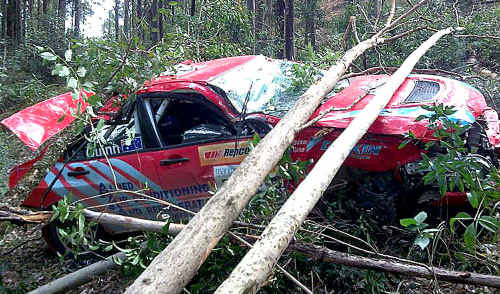
This week’s expedition takes us on a trek to find lost rally cars. The World over, rally cars are unfortunately a bit disposable due to the abuse they see while being used in competition. Rally is devastating to cars and equipment, even if a car never sees a bad crash. After constant use and abuse it’s hard to keep them straight and it’s even harder to keep them up to safety specs. It’s easy to keep a 40+ year old road race car up to specs but with rally, it’s nearly impossible without a large investment. With those factors in play, it is pretty common place to see used, semi-competitive rally cars selling very cheap and it’s very common to find them parked, just wasting away. I put my best Indiana Jones custom on and go searching for the holy grail of junked rally cars. Group B Dumpster/Treasure Chest
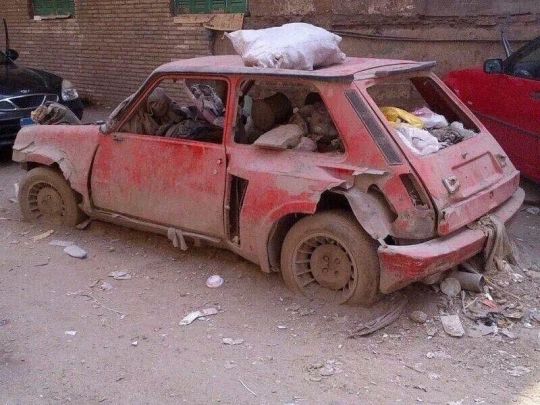
A Renault R5 Turbo and this isn’t just a normal R5, it’s an Evo 2 which were the homologation version built to make the R5 eligible for Group B rally racing. There were only 200 of the Evo 2 cars built! Seeing this one sitting there, used as a dumpster is heart breaking.
Skeletal Remains

Alright, I admit it, I have a bit of a fetish for the Lancia Stratos. Growing up in the States we didn’t see much Group B rally back in the day due to the lack of US media caring about international rally racing (and no, there wasn’t internet back then), the only time we saw Group B was in racing magazines, usually from Europe that would end up in the race shop being passed down from another shop or a race team. In 1990 my fetish started after seeing one at Willow Springs during a test day. Most would see this neglected Stratos as an eyesore, it is basically just part of the chassis and doors. It is way to expensive to rebuild but I want to take it home and use it as a lawn ornament.
Forgotten Gems
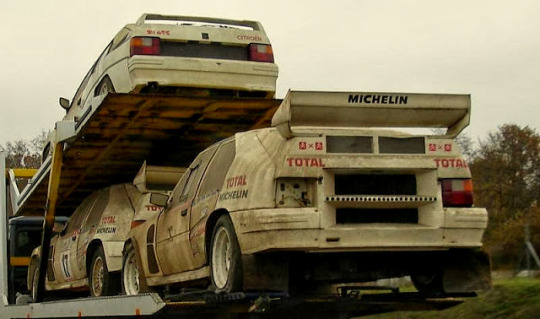
The 80s Citroen rally cars were never very popular due to the lack of… well everything except weight. The BX line of cars (there were a handful of different versions made/developed) exceeded the minimum weight requirements by almost 450lbs.! While weight was one issue, it was just one of MANY issues, they were slow, they handled horribly, they were unreliable, they were a mess! So why would we feature them here? Because no matter how bad they were, they are still very cool and very rare. And finding three of them, a BX 4TC, a BX 4TC Sport and a BX 4TC Evolution on the same transport truck just wasting away in Southern France is equivalent to finding the missing gold treasure of Billy the Kid.
Hidden in plain sight

Now what we have here is a very cool find, a Peugeot 205 Rallye. The 205 cars were commonplace in Europe for 15 years, you could get a boring one, a loaded/luxury one, a sporty one, a fast one and then one ready to race. Peugeot teamed up with Talbot Sport to make a almost race ready car available right from the dealer. The 205 Rallye came with a tuned engine, a closer ratio gear box, tweaked suspension and absolutely no creature comforts including sound deadening. They expected to sell 5000 over a 4 year time period but the cars were so popular they sold over 30,000 of them!
Like finding Atlantis

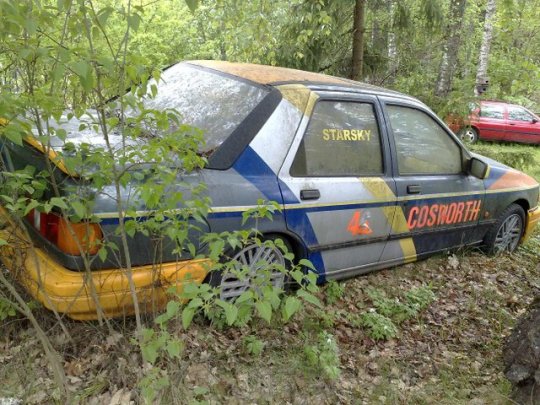
The Ford Cosworth, we could write a book about this motor and the cars that Ford has put them in, each and every one of them has been a winner. In rally the Cosworth Fords were the what legends are made of. The Escorts, the Sapphires, the XRs, the RS500 and the RS200 all had Cosworths powering them. The combination led to countless rally and rally championship wins with masters like Carlos Sainz, Ari Vatanen, Didier Auriol and Stig Blomqvist behind the wheel. A mint Ford Cosworth (any model) will fetch big money when sold and thrashed, forgotten cars like the RS500 and the Sapphire shown here will still bring more money than most normal cars sitting at your local used car dealer. Yard Sale
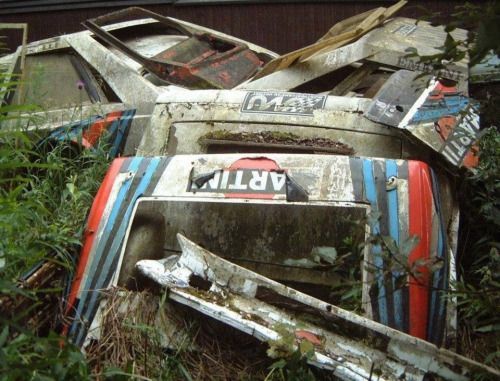
The Lancia Delta has a rally history that most other cars dream that they had. The Italian car maker who had been heavily involved in rally for decades hit it big with the Delta. They finally had a car that won in all conditions and all terrains, they were so capable that they even made mediocre drivers shine bright. The cars become so popular that Lancia produced dozens of versions, each of them very focused on being the ultimate driving machine for it’s targeted buyer. At the top of the line is the Delta HF Intergrale Evoluzione (yes, that is spelled correctly) II which was loaded with high performance features that have just recently started showing up in modern cars.
Fools Gold?

The car responsible for bringing AWD to rally, the Audi Quattro. The Quattro cars made their debut in 1980 but it wasn’t until 1984 when the Quattro S1 versions hit the rally stages that things got serious. The S1 cars were entirely different kind of rally car, as long as they stayed together or weren’t in an accident, they were virtually impossible for competitors to match. The car you see here has to be a replica or does it? The whereabouts of all but a handful of the S1 cars are known and those not accounted for were written off in accidents. So what do we have here? Of course a replica is the obvious answer but there are rumors that have been swirling in the rally community for years that the car pictured here was a car given as a gift to Walter Rohrl (Audi rally driver) by Audi. Though Audi nor Walter have never commented. Even if it is a replica it is worth big money as a replica is currently being sold in the States for $180,000. A find like that of Oak Island

Alright, I admit it, the title on this one is a little bit mean but I am making fun of myself. I love the Curse of Oak Island TV show and I love Triumph TR7 and TR8 cars but both of these things have the same thing in common, is there really treasure? The Triumph TR cars are weird, weird in good and bad ways. They are fun, they are amazing fun to drive, that is when they run. Many will argue that there are more unreliable cars, and I am sure there are but these are absolute shit! I seriously don’t understand how or why I have owned and raced two of them nor do I understand why I am still attracted to them. Did I mention that they are shit? Sure it made sense for Triumph to race them, they had to make the public want them and want them we did. On track and on asphalt/tarmac rallies the Triumphs were damn fast. But seriously finding this, I don’t know if I would be tempted to grab it, even if the immediate risk of being rolled over by a giant rock didn’t exist, I would know that every day after I grabbed it would be cursed. The small finds are the greatest

The Mini is a very important car, it is the car that made it possible for everyone to feel that they could be a rally driver. The first Mini hit the rally stages in 1960 but in 1962 a Mini driven by Paddy Hopkirk won the Monte Carlo rally which at the time was the most prestigious rally in the World. It was so big that even the press in the USA gave it some attention. Over a twelve year time span, Mini won dozens of rallies, it also won dozens of touring car championships and races. The Mini is arguably one of the most important production race cars ever! Finding one with documented rally heritage and being able to rescue it would be equal to finding something as special as finding the treasure of the Knights Templar.
2 notes
·
View notes